Planning for the Unthinkable: The targeting strategies of nuclear-armed states
This report was produced with generous support from Norwegian People’s Aid.
The quantitative and qualitative enhancements to global nuclear arsenals in the past decade—particularly China’s nuclear buildup, Russia’s nuclear saber-rattling, and NATO’s response—have recently reinvigorated debates about how nuclear-armed states intend to use their nuclear weapons, and against which targets, in what some describe as a new Cold War.
Details about who, what, where, when, why, and how countries target with their nuclear weapons are some of states’ most closely held secrets. Targeting information rarely reaches the public, and discussions almost exclusively take place behind closed doors—either in the depths of military headquarters and command posts, or in the halls of defense contractors and think tanks. The general public is, to a significant extent, excluded from those discussions. This is largely because nuclear weapons create unique expectations and requirements about secrecy and privileged access that, at times, can seem borderline undemocratic. Revealing targeting information could open up a country’s nuclear policies and intentions to intense scrutiny by its adversaries, its allies, and—crucially—its citizens.
This presents a significant democratic challenge for nuclear-armed countries and the international community. Despite the profound implications for national and international security, the intense secrecy means that most individuals—not only including the citizens of nuclear-armed countries and others that would bear the consequences of nuclear use, but also lawmakers in nuclear-armed and nuclear umbrella states that vote on nuclear weapons programs and policies—do not have much understanding of how countries make fateful decisions about what to target during wartime, and how. When lawmakers in nuclear-armed countries approve military spending bills that enhance or increase nuclear and conventional forces, they often do so with little knowledge of how those bills could have implications for nuclear targeting plans. And individuals across the globe do not know whether they live in places that are likely to be nuclear targets, or what the consequences of a nuclear war would be.
While it is reasonable for governments to keep the most sensitive aspects of nuclear policies secret, the rights of their citizens to have access to general knowledge about these issues is equally valid so they may know about the consequences to themselves and their country, and so that they can make informed assessments and decisions about their respective government’s nuclear policies. Under ideal conditions, individuals should reasonably be able to know whether their cities or nearby military bases are nuclear targets and whether their government’s policies make it more or less likely that nuclear weapons will be used.
As an organization that seeks to empower individuals, lawmakers, and journalists with factual information about critical topics that most affect them, the Federation of American Scientists—through this report—aims to help fill some of these significant knowledge gaps. This report illuminates what we know and do not know about each country’s nuclear targeting policies and practices, and considers how they are formulated, how they have changed in recent decades, whether allies play a role in influencing them, and why some countries are more open about their policies than others. The report does not claim to be comprehensive or complete, but rather should be considered as a primer to help inform the public, policymakers, and other stakeholders. This report may be updated as more information becomes available.
Given the secrecy associated with nuclear targeting information, it is important at the outset to acknowledge the limitations of using exclusively open sources to conduct analysis on this topic. Information in and about different nuclear-armed states varies significantly. For countries like the United States—where nuclear targeting policies have been publicly described and are regularly debated inside and outside of government among subject matter experts—official sources can be used to obtain a basic understanding of how nuclear targets are nominated, vetted, and ultimately selected, as well as how targeting fits into the military strategy. However, there is very little publicly available information about the nuclear strike plans themselves or the specific methodology and assumptions that underpin them. For less transparent countries like Russia and China—where targeting strategy and plans are rarely discussed in public—media sources, third-country intelligence estimates, and nuclear force structure analysis can be used, in conjunction with official statements or statements from retired officials, to make educated assumptions about targeting policies and strategies.
It is important to note that a country’s relative level of transparency regarding its nuclear targeting policies does not necessarily echo its level of transparency regarding other aspects of its governance structure. Ironically, some of the most secretive and authoritarian nuclear-armed states are remarkably vocal about what they would target in a nuclear war. This is typically because those same countries use nuclear rhetoric as a means to communicate deterrence signals to their respective adversaries and to demonstrate to their own population that they are standing up to foreign threats. For example, while North Korea keeps many aspects of its nuclear program secret, it has occasionally stated precisely which high-profile targets in South Korea and across the Indo-Pacific region it would strike with nuclear weapons. In contrast, some other countries might consider that frequently issuing nuclear threats or openly discussing targeting policies could potentially undermine their strategic deterrent and even lower the threshold for nuclear use.
Federation of American Scientists Researchers Contribute Nuclear Weapons Expertise to International SIPRI Yearbook, Out Today
The Stockholm International Peace Research Institute (SIPRI) launches its annual assessment of the state of armaments, disarmament and international security
Washington, D.C. – June 16, 2025 – Nuclear weapons researchers at the Federation of American Scientists (FAS) contributed to the Stockholm International Peace Research Institute (SIPRI)’s annual Yearbook, released today. Key findings of SIPRI Yearbook 2025 are that a dangerous new nuclear arms race is emerging at a time when arms control regimes are severely weakened.
“The era of reductions in the number of nuclear weapons in the world, which had lasted since the end of the cold war, is coming to an end,” said Hans M. Kristensen, Associate Senior Fellow with SIPRI’s Weapons of Mass Destruction Programme and Director of the Nuclear Information Project at the Federation of American Scientists (FAS). “Instead, we see a clear trend of growing nuclear arsenals, sharpened nuclear rhetoric and the abandonment of arms control agreements.”
World’s nuclear arsenals being enlarged and upgraded
Nearly all of the nine nuclear-armed states—the United States, Russia, the United Kingdom, France, China, India, Pakistan, the Democratic People’s Republic of Korea (North Korea) and Israel—continued intensive nuclear modernization programmes in 2024, upgrading existing weapons and adding newer versions.
Of the total global inventory of an estimated 12,241 warheads in January 2025, about 9614 were in military stockpiles for potential use (see the table below). An estimated 3912 of those warheads were deployed with missiles and aircraft and the rest were in central storage. Around 2100 of the deployed warheads were kept in a state of high operational alert on ballistic missiles. Nearly all of these warheads belonged to Russia or the USA, but China may now keep some warheads on missiles during peacetime.
Since the end of the cold war, the gradual dismantlement of retired warheads by Russia and the USA has normally outstripped the deployment of new warheads, resulting in an overall year-on year decrease in the global inventory of nuclear weapons. This trend is likely to be reversed in the coming years, as the pace of dismantlement is slowing, while the deployment of new nuclear weapons is accelerating.
Russia and the USA together possess around 90 per cent of all nuclear weapons. The sizes of their respective military stockpiles (i.e. useable warheads) seem to have stayed relatively stable in 2024 but both states are implementing extensive modernization programmes that could increase the size and diversity of their arsenals in the future. If no new agreement is reached to cap their stockpiles, the number of warheads they deploy on strategic missiles seems likely to increase after the bilateral 2010 Treaty on Measures for the Further Reduction and Limitation of Strategic Offensive Arms (New START) expires in February 2026.
The USA’s comprehensive nuclear modernization programme is progressing but in 2024 faced planning and funding challenges that could delay and significantly increase the cost of the new strategic arsenal. Moreover, the addition of new non-strategic nuclear weapons to the US arsenal will place further stress on the modernization programme.
Russia’s nuclear modernization programme is also facing challenges that in 2024 included a test failure and the further delay of the new Sarmat intercontinental ballistic missile (ICBM) and slower than expected upgrades of other systems. Furthermore, an increase in Russia’s non-strategic nuclear warheads predicted by the USA in 2020 has so far not materialized.
###
ABOUT FAS
The Federation of American Scientists (FAS) works to advance progress on a broad suite of contemporary issues where science, technology, and innovation policy can deliver transformative impact, and seeks to ensure that scientific and technical expertise have a seat at the policymaking table. Established in 1945 by scientists in response to the atomic bomb, FAS continues to bring scientific rigor and analysis to address contemporary challenges. More information about FAS work at fas.org.
Nuclear Notebook: Russian Nuclear Weapons 2025 Federation of American Scientists Unveils Comprehensive Analysis of Russia’s Nuclear Arsenal
Washington, D.C. – May 6, 2025 – The Federation of American Scientists (FAS) today released “Nuclear Notebook: Russian Nuclear Weapons 2025,” its authoritative annual survey of Russia’s nuclear weapons arsenal. The FAS Nuclear Notebook is considered the most reliable public source for information on global nuclear arsenals for all nine nuclear-armed states. FAS has played a critical role for almost 80 years to increase transparency and accountability over the world’s nuclear arsenals and to support policies that reduce the numbers and risks of their use.
This year’s report, published in the Bulletin of the Atomic Scientists and by Taylor & Francis and available in full here, discusses the following takeaways:
- Russia currently maintains nearly 5,460 nuclear warheads, with an estimated 1,718 deployed. This represents a slight decrease in total warheads from previous years but still positions Russia as the world’s largest nuclear power alongside the United States.
- Russia continues to modernize its nuclear triad, replacing Soviet-era weapons with newer types, but modernization of ICBMs and strategic bombers has been slow. The country’s efforts to develop the advanced Sarmat (RS-28 or SS-29) ICBM and the next-generation strategic bomber, PAK DA, have faced delays and setbacks.
- The submarine-based nuclear force continues its modernization with Borei-class submarines replacing older types. A portion of Russian ballistic missile submarines are at sea at any given time on strategic deterrent patrols. Significant nuclear warhead and missile storage upgrades are underway at the Pacific and Northern fleet bases.
- Russia continues modernizing and emphasizing its nonstrategic nuclear forces. This includes land- and sea-based dual-capable missiles and tactical aircraft. Despite modernization of launchers, the number of warheads assigned to those launchers has remained relatively stable. Russia held several high-profile exercises with its nonstrategic forces in 2024, and the authors describe upgrades to a suspected nuclear storage depot in Belarus.
- Russia has maintained its policy of nuclear deterrence, emphasizing the strategic importance of its nuclear arsenal in its military doctrine. Updates to public policy documents describe a broader range of scenarios for potential use of nuclear weapons but it is unknown to what extent this is reflected in changes to military plans.
FAS Nuclear Experts and Previous Issues of Nuclear Notebook
The FAS Nuclear Notebook, co-authored by Hans M. Kristensen, Matt Korda, Eliana Johns, and Mackenzie Knight, is published bi-monthly in the Bulletin of the Atomic Scientists. The first Nuclear Notebook was published in 1987. FAS, formed in 1945 by the scientists who developed the first U.S. nuclear weapon, has worked since to increase nuclear transparency, reduce nuclear risks, and advocate for responsible reductions of nuclear arsenal and their role.
This latest issue on Russia’s nuclear weapons comes after the release of Nuclear Notebook: Chinese Nuclear Weapons 2025 and will be followed in June by Nuclear Notebook: French Nuclear Weapons 2025. More research available at FAS’s Nuclear Information Project.
The Federation of American Scientists’ work on nuclear transparency would not be possible without generous support from the Carnegie Corporation of New York, the Joseph Rowntree Charitable Trust, the Jubitz Family Foundation, the New-Land Foundation, Ploughshares, the Prospect Hill Foundation, and individual donors.
###
ABOUT FAS
The Federation of American Scientists (FAS) works to advance progress on a broad suite of contemporary issues where science, technology, and innovation policy can deliver transformative impact, and seeks to ensure that scientific and technical expertise have a seat at the policymaking table. Established in 1945 by scientists in response to the atomic bomb, FAS continues to bring scientific rigor and analysis to address contemporary challenges. More information about FAS work at fas.org.
Depot In Belarus Shows New Upgrades Possibly For Russian Nuclear Warhead Storage
A military depot in central Belarus has recently been upgraded with additional security perimeters and an access point that indicate it could be intended for housing Russian nuclear warheads for Belarus’ Russia-supplied Iskander missile launchers.
The upgraded enclosure is located inside an existing military depot east of the town of Ashipovichy. Leaked documents on Discord indicated that in February 2023, the CIA reported that “a senior officer from the Russian Ministry of Defense inspected a facility in the vicinity of Asipivochy [sic] for potential upgrades” to serve as “a nuclear warhead storage facility in Belarus” (see excerpt of CIA leaked report below).

This part of a leaked CIA document reported Russian inspection of Asipovichy for potential nuclear warhead storage.
A satellite image provided by Maxar Technologies shows that part of the depot near Asipovichy has since been upgraded with a quadruple-fence security perimeter and a roof-covered guarded access point (see image below).
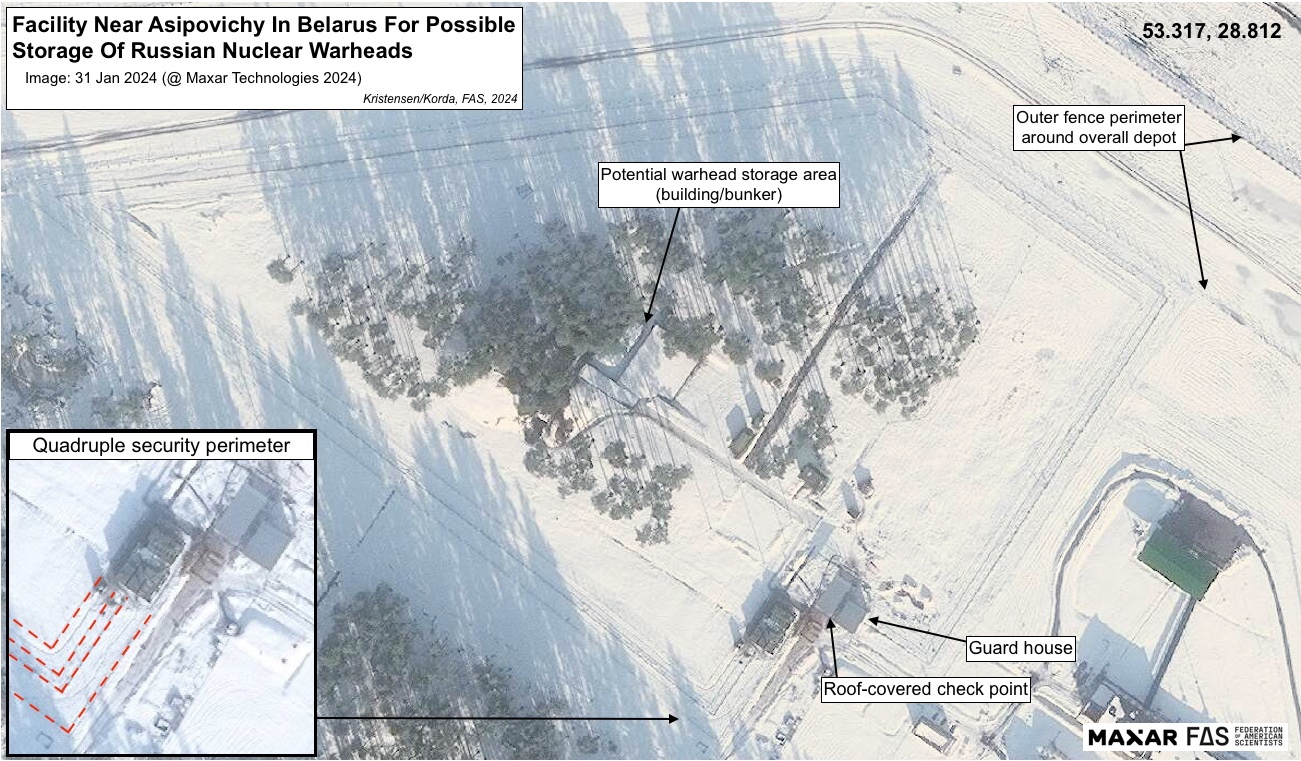
Upgrades to Asipovichy depot now shows quadruple security perimeter.
Satellite images show that construction began at the facility around the time of the reported visit by the senior Russian official. The upgrades have progressed slowly, with the initial construction of a double-layer security perimeter. That would be insufficient for storage of nuclear warheads. In October 2023 construction of a new perimeter began inside the existing security perimeter, and the Maxar image from late-January 2024 shows what appears to be a total of four security perimeters. The construction of the added perimeters shows significant digging for what could potentially be cables and various sensors. Trees within the new inner perimeter have also been cleared by approximately 20 meters away from the fencing.
If so, these upgrades would more closely resemble the level of physical protection that Russian authorities would require for storage of nuclear weapons.
Russian and Belarusian statements over the past two years have repeatedly claimed that nuclear weapons had been brought to Belarus, but we had previously not seen clear evidence that facilities had been readied for that purpose.
Earlier today, under the headline “Russian Nuclear Weapons Are Now In Belarus,” Foreign Policy reported that “Western officials,” including the Lithuanian defense minister, “confirmed the news of the deployment.” The article says that “a senior Lithuanian diplomat and other Western officials indicated to Foreign Policy that Russia had built specific storage facilities and railway systems in Belarus to potentially house a nuclear arsenal.”
It remains unclear if the confirmations referred to nuclear-capable launchers or the actual warheads for those launchers. But the upgrade at the Asipovichy depot shows security features that potentially could match upgrades required for nuclear warhead storage at the same facility that the Russian defense official apparently inspected one year ago.
If nuclear warheads have indeed been moved to Belarus, it does not give Russia a significant military advantage in eastern Europe. Russia already maintains modernized nuclear storage facilities in Kaliningrad and has long had the ability to target NATO countries with nuclear weapons. Instead, the deployment appears designed to unnerve NATO’s eastern-most member states and highlight Russia’s status as a nuclear power.
Additional background information:
• Nuclear Weapons Sharing, 2023
• Belarus “Nuclear-Capable” Iskanders Get A New Garage
• Russian Nuclear Weapons Deployment Plans In Belarus: Is There Visual Confirmation?
• Russian Nuclear Weapons In Belarus? A CNS Roundtable Discussion
• Video Indicates That Lida Air Base Might Get Russian “Nuclear Sharing” Mission In Belarus
• Geo-Location of Russian-Supplied Iskander Launchers Training at Osipovichi i Belarus
This research was carried out with generous contributions from the the New-Land Foundation, Ploughshares Fund, the Prospect Hill Foundation, Longview Philanthropy, and individual donors.
Details of Russia’s nuclear modernization are inconsistent with warnings of vast nuclear expansion
While many are rightly concerned about Russia’s development and fielding of new nuclear-capable systems, a few key points about Russia’s nuclear modernization provide critical context into Moscow’s threat perceptions and strategic priorities and suggest that fears of a substantial Russian nuclear increase or change in the strategic environment might be overblown.
First, Russia’s nuclear force modernization is driven mainly by the need to replace older Soviet-era systems that are aging out. Just like every nuclear-armed state, the goal of Russia’s modernization campaign is to ensure that its forces are ready to operate in today’s environment and to support existing deterrence and strategic requirements. The initiation of these modernization programs does not necessarily depend on the adoption of a new nuclear strategy and posture but simply on when the systems were first fielded decades ago. The percentage of newer Russian nuclear systems compared to Soviet-era systems has long been an important public metric for Putin, who announced last month that 95% of Russian strategic systems had been modernized.
Second, Russia sees U.S. missile defense capabilities as a real future risk. Because of this, we see Russia developing certain capabilities that are specifically designed to challenge U.S. missile defenses. For instance, Russia reportedly plans to replace its silo-based Topol-M intercontinental ballistic missile (ICBM) by 2030 with a new “Yars-M” ICBM variant that is under development. Compared to the single-warhead Topol-M ICBM, the Yars-M system will apparently carry multiple warheads with individual propulsion systems in a parallel staging configuration, which would theoretically allow for greater survivability against missile defenses given that warhead separation would take place at an earlier stage in flight. It would also potentially allow Russia to field more warheads compared with the Topol-M system.
Additionally, we also see Russia developing hypersonic missiles that are designed to evade U.S. missile defense systems. Russia deployed upgraded SS-19 Mod 4s with its new Avangard hypersonic glide vehicle (HGV) and is also rumored to be developing new HGVs that can be fitted atop modified ICBMs. Russia is also developing a new Kh-95 hypersonic air-launched cruise missile (ALCM) and has frequently touted the “hypersonic” nature of the Kinzhal long-range, air-launched ballistic missile that can be launched from specially modified MiG-31Ks. These developments, however, are not a strategic game-changer. A ‘hypersonic’ weapon broadly means anything that travels above Mach 5, which already includes existing ICBMs. While hypersonic cruise missiles and hypersonic glide vehicles are more difficult to intercept, the United States is already developing new missile defense interceptors specifically designed to counter these capabilities, and Russia’s war in Ukraine has also proven that ‘hypersonic’ missiles such as the Kinzhal are capable of being shot down in a real-world scenario.
Notably, many of Russia’s modernization programs have also been facing serious setbacks. From the Sarmat ICBM to the Burevestnik intercontinental-range nuclear-powered, ground-launched, nuclear-armed cruise missile to the Poseidon nuclear-powered, long-range, nuclear-armed torpedo to the modernized Tu-160M bombers, many different systems are undergoing modernization programs simultaneously. On top of additional sanctions, supply chain deficiencies, and technical challenges, the concurrent development and modernization of several systems is causing significant delays to planned deployment schedules.
Russia’s modernization plans seem focused on maintaining parity with the United States and cultivating prestige, especially in the midst of its lack of success in Ukraine. Indeed, some of Russia’s new nuclear systems under development appear to mirror new U.S. systems, but their development is lagging in comparison. For example, while the United States’ new strategic bomber under development–the B-21 Raider–has completed two confirmed test flights and entered low-rate initial production, Russia’s PAK DA bomber, also taking on a flying wing design, has been marred by delays. A full prototype has yet to be completed, despite research and development starting several years before the Raider.
The threat from Russia’s tactical nuclear arsenal also appears to have been overblown. The U.S. Defense Intelligence Agency’s 2021 Worldwide Threat Assessment and the State Department’s 2023 New START implementation report stated that Russia likely possesses 1,000-2,000 tactical nuclear warheads, though the State Department estimate included retired warheads awaiting dismantlement. In 2022, some officials warned that Russia’s tactical nuclear arsenal could double by 2030. Despite these warnings, our team has observed no evidence of such an increase and have instead lowered our estimate to approximately 1,558 nonstrategic nuclear warheads. There is little authoritative public information available to support the rumors of a massive Russian increase of tactical nuclear weapons.
Despite all these developments, Russia’s current and planned force structure does not fundamentally ‘rock the boat.’ Russia’s nuclear modernization won’t change the fact that Russia still has fewer strategic launchers than the United States. Russia may be modernizing and developing new nuclear-capable systems, but it is not significantly building up its nuclear forces: Russia is replacing Soviet-era missiles with newer types on a less-than-one-for-one basis, we do not observe an increase in the number of warheads assigned for delivery by tactical forces, and we don’t see any changes in force posture on the ground. Russia’s claimed deployment of tactical nuclear weapons to Belarus is likely meant to primarily discourage the United States and NATO from further intervention in the war in Ukraine. Because of the existing presence of Russian dual-capable forces and nuclear weapons storage in the Kaliningrad region, the presence of tactical nuclear weapons in Belarus does not change the strategic environment and likely reflects a contingency plan rather than a permanent deployment.
Despite Putin’s nuclear threats during the war in Ukraine, and despite alarmist reports to the contrary, there has been no significant change in Russia’s nuclear strategy, which has largely remained relatively consistent for decades. Russia has frequently used nuclear threats in the past to try to affect geopolitics, including in regard to NATO expansion, western aid to Ukraine, and the deployment of U.S. missile defenses in Europe in 2008; however, there is no public indication that these signals necessarily portend a lowering of Russia’s nuclear threshold.
None of this is to say that Russian nuclear modernization and development is not a problem or cause for concern; Russia’s modernization of its nuclear forces, in addition to threats of nuclear action against other nations, creates ambiguity and concern surrounding Russia’s long-term intentions. Overinflation of the threat, however, will lead to miscalculation, calls for unnecessary increases to the U.S. nuclear force structure, and resistance to much-needed arms control efforts. We must be wary of letting worst-case scenario thinking push us into a dangerous arms race and unstable security situation, particularly when global tensions are so high and the United States is already planning to spend over $1 trillion on nuclear weapons programs over the next 30 years.
This research was carried out with generous contributions from the New-Land Foundation, Ploughshares Fund, the Prospect Hill Foundation, Longview Philanthropy, and individual donors.
Nuclear Notebook: Russian nuclear forces, 2024
The Federation of American Scientists has released its annual estimate of the size and makeup of Russia’s nuclear forces. The total number of nuclear warheads are now estimated to include 4,380 stockpiled warheads for operational forces, as well as an additional 1,200 retired warheads awaiting dismantlement, for a total inventory of 5,580 warheads.
Despite modernization of Russian nuclear forces and warnings about an increase of especially shorter-range non-strategic warheads, we do not yet see such an increase as far as open sources indicate. For now, the number of non-strategic warheads appears to be relatively stable with slight fluctuations. Although our new estimate of this category is lower than last year, that is not because of an actual decrease in the force level but because we have finetuned assumptions about the number of warheads assigned to Russian non-strategic nuclear forces. Our new estimate of roughly 1,558 non-strategic warheads is well within the range of 1,000-2,000 warheads estimated by the U.S. Intelligence Community for the past several years.
While Russia’s nuclear statements and threatening rhetoric are of great concern, Russia’s nuclear arsenal and operations have changed little since our 2023 estimates beyond the ongoing modernization. In the future, however, the number of warheads assigned to Russian strategic forces may increase as single-warhead missiles are replaced with missiles equipped with multiple warheads. If the New START treaty is not replaced with a new agreement, both Russia and the United States could potentially increase the number of deployed warheads.
Also in the Nuclear Notebook: Russian nuclear forces, 2024, is our latest analysis on Russian force modernization and strategy:
- Russian nuclear force modernization, intended to replace Soviet-era missiles, aircrafts, and submarines with new systems, continues at a steady pace.
- Modernization of road-mobile intercontinental ballistic missiles is essentially complete with focus shifting to modernizing silo-based missiles.
- New strategic and non-strategic submarines continue to replace Soviet-era models but with enhanced nuclear weapon systems.
- Upgrades and some reproduction of Soviet-era strategic bombers continue with new long-range cruise missiles.
- News leaks seem to indicate that Russia might be developing a nuclear-armed anti-satellite weapon which, if deployed in the future, would violate the Outer Space Treaty.
- Upgrades of nuclear weapons storage facilities are underway at several bases to accommodate the weapons for modernized forces.
- Because Russian conventional forces have been significantly depleted and their effectiveness questioned by the war in Ukraine, nuclear forces will likely be seen as important to compensate for that weakness.
The FAS Nuclear Notebook, published in the Bulletin of the Atomic Scientists, is widely considered the most accurate public source for information on global nuclear arsenals for all nine nuclear-armed states.
ABOUT FAS
The Federation of American Scientists (FAS) works to advance progress on a broad suite of contemporary issues where science, technology, and innovation policy can deliver dramatic progress, and seeks to ensure that scientific and technical expertise have a seat at the policymaking table. Established in 1945 by scientists in response to the atomic bomb, FAS continues to work on behalf of a safer, more equitable, and more peaceful world. More information at fas.org.
This research was carried out with generous contributions from the New-Land Foundation, Ploughshares Fund, the Prospect Hill Foundation, Longview Philanthropy, and individual donors.
For Heaven’s Sake: Why Would Russia Want to Nuke Space?
It can be more than a little scary to look into the mind of a dangerous dictator like Vladimir Putin. But as Russia has several thousand nuclear weapons, managing stability and avoiding nuclear war requires that America try to understand what is happening with both the mind of the country’s leader and capabilities of its military. Deterrence is about understanding how our actions influence that of others, and vice versa. Thus, it remains essential to consider what Russia (and other adversaries) is pursuing in terms of possible contingencies, and interpret changes in military and strategic capabilities.
So when news broke in February that Russia was reportedly building some nuclear connected anti-satellite weapon, a lot of people started scratching their heads. First, because of the manner in which the news was leaked. Congressman Mike Turner seemed to get ahead of both the process and the intelligence itself, and created a bit of a panic by demanding full and immediate declassification of all information about the system. It now seems this was alarmist, and perhaps motivated by other political factors. Leaks seemed to indicate that Russia might be planning to launch a nuclear-powered anti-satellite directed energy weapon into space. U.S. officials are reportedly telling allies Russia could launch the system into space within the next year. Details became a little clearer, thanks to a public briefing by White House Advisor Adm. John Kirby. Kirby confirmed that the planned system was still in development, and President Biden later said it was not clear if and when the system would be deployed. Importantly, Kirby also stated that the system, if deployed, would violate the Outer Space Treaty of 1967. That phrase made clear that the Russian program involved placing a nuclear weapon in outer space, since deploying nuclear weapons in space is the main and only specific constraint contained in the OST.
What Can Putin Be Thinking?
We can speculate that the Russian program would involve deploying a nuclear device in orbit, presumably with some maneuvering capability so that it can be detonated to disable satellites. A nuclear explosion in space would create a series of devastating effects, including an electromagnetic pulse, and longer-lasting radiation that would circle the earth and dramatically compromise satellite communications world-wide. Some hardened assets might survive, but other unshielded military and almost all non-shielded commercial satellites would be potentially vulnerable. The global economic and communications system could be shut down or destroyed for years, and some orbits made hazardous – if not unusable – for an extended period due to space debris.
Who would do such a thing? Well, the Soviet Union and the United States considered a lot of dangerous nuclear ideas during the Cold War, including detonating nuclear weapons in outer space to blind an adversary’s space assets. The U.S. had a program in the 1960s called Casaba Howitzer, which would use nuclear explosions to drive energy beams to attack space assets. Both states tested nuclear weapons at high altitudes and considered using nuclear weapons in space. So the idea is not new. It was just rejected as reckless and dangerous for a variety of good reasons. Making space unusable is one. Leaving nuclear weapons in orbit – unprotected and out of positive human control and potentially liable to uncontrolled reentry – are two more.
So why would Russia return to this really dangerous idea now? There are at least three explanations that have some credibility (and possibly more as some of my colleagues have pointed out).
Explanation 1: Go After American Power Asymmetrically
The first plausible explanation is that in the 2000s, as Russia’s conventional military was weak and being rehabilitated, Vladimir Putin threw a lot of money at the Russia nuclear complex to come up with programs that could undermine America’s advantages. This funding led to a number of very unorthodox nuclear programs including the now famous Poseidon long-range, underwater nuclear-armed torpedo and the Skyfall, a nuclear-powered, nuclear-tipped cruise missile that can fly for days and attack its targets from unexpected angles. Both of these programs were conceived of decades ago, but did not get fully funded or deployed during the Cold War. When the USSR collapsed, these programs all withered. Both novel systems have found new support under Putin, who has touted them in multiple speeches.
The as-yet unnamed nuclear-armed satellite killer (How about Starburst for a name?) could be another such device, brought back to life from the Soviet archives to go after American power asymmetrically. As America relies heavily on space for military operations, countering it could make it easier for Russia to go toe to toe with the west in a conflict. It could be that this program was mothballed when the USSR collapsed but rehabilitated when new money was available, and details were only available recently in the later stages of development. Thus, it should not be assumed that there is a clear use strategy or specific scenario in mind behind the weapon. Both Moscow and Washington (and now some speculate China as well with its own nuclear expansion) have long histories of pursuing nuclear programs because they could, and then figuring out how to use them later.
Explanation 2: Nuclear “Insurance Policies”
A second motive is less benign than just technical and financial opportunity, and would involve Russia explicitly seeking programs and capabilities that could go after American nuclear control capabilities in a crisis to prevent America from attacking Russia first. This could be considered consistent with Russia’s stated but dangerously provocative “escalate to de-escalate strategy.” Russia’s fear is also likely behind the Poseidon and Skyfall, since both of these systems are more fittingly thought of as retaliatory, and not first strike weapons. Neither move fast enough to disarm the U.S. and are mainly good for firing after an attack. Thus, many in Russia likely consider them nuclear insurance policies; if Washington ever decided to pursue a disarming first strike made up of American conventional and nuclear assets, and backed by U.S. missile defenses (known in Russia as the splendid strike threat) enough Russian nuclear weapons would survive to destroy America, keeping deterrence intact. It is hard, and actually morally offensive, to have sympathy for Vladimir Putin, but there is a long history of fear as a motive and a sense of encirclement that permeates his regime. Thus, many of these nuclear programs – including the new nuclear armed space system – could be seen in this light. If this is an explanation for other novel nuclear systems, then it could also be part of the motive for the new space/nuclear option.
Explanation 3: Put America’s Technical Advantages at Risk
The third motive is one that probably resonates with most observers of Putin’s long and brutal time in office, marked by political assassinations and repression at home and multiple wars abroad. This possible motive is one where Putin is investing in capabilities that could cripple America in a run up to a direct conflict with Moscow. Being able to detonate a nuclear weapon in space and damage, if not destroy America’s extensive constellations of military satellites could be seen by Russia as both useful and even necessary to prepare for a possible conflict with the west and America. Its threatened use could be used to try and force America to back down in a crisis, or even used preemptively as a prelude to a major military move by Putin against NATO or America itself. As a weapon of aggression, a space-based device could put America’s considerable technical advantages at risk, thus explaining why some have expressed concern about America’s urgent need to upgrade its command and control systems and improve its resilience in space launch and satellite systems. Interestingly, in the move and counter-move process of deterrence and warfare, America’s investment in smaller, resilient constellations of satellites may have increased Russia’s interest in systems that can disable large numbers of assets as opposed to direct assent, kinetic anti-satellite weapons.
So why is Russia pursuing such a program? The bottom line is we don’t really know. Despite spending $50 billion a year on nuclear weapons, $900 billion on defense broadly, and $70 billion on intelligence, we don’t have as much insight into Russia’s nuclear doctrine or Putin’s inner thinking as we might want. All three of the motives laid out above are plausible; it’s also possible that a combination of the three are driving the Russian leader. We may never know.
Still, an important question remains regarding what the U.S. should do in response. Legally and morally, the U.S. and its allies should call out any such illegal and dangerous effort for what it is – madness. Detonating a nuclear weapon in space would not only damage U.S. assets but those of all countries, including Russia (China, India etc). It would set back the use of space for multiple purposes – peaceful and otherwise – by decades.
The Russia space program puts even greater emphasis on the need for America to insulate its space assets, diversify its systems to deal with space attacks, and develop more resilient space capabilities including through rapid relaunch abilities. In a conflict, demonstrating that the U.S. can quickly launch and replace critical space-based assets may be one way to deter Russia from ever using such a crazy and dangerous device. If doing so provides no material advantage, the need or urge to use it goes way down. Such resiliency requires considerable investment and U.S. leaders should also be mindful of an overreliance on private space launch capabilities, which while important cannot replace the Government’s own ability to protect American assets.
However this resiliency is developed – it will be expensive. But consider the money the U.S. is investing in redundant and arguably unnecessary nuclear overkill – including the new nuclear land based intercontinental ballistic missile that has now ballooned from an estimated $62B in 2015 to over $130 billion, a number which may still be climbing. Perhaps redirecting some of that nuclear funding to more urgent and useful priorities would be a better investment.
This research was carried out with generous contributions from the New-Land Foundation, Ploughshares Fund, the Prospect Hill Foundation, Longview Philanthropy, and individual donors.
Upgrades to Russia’s Nuclear-Capable Submarine Fleet
[With updated graphic] Russia is in the midst of a decades-long nuclear force modernization program intended to replace Soviet-era missiles, aircraft, and submarines with new systems. As part of this project, Russia’s Navy is currently modernizing its nuclear-powered ballistic missile submarine (SSBN) fleet and building new nuclear-powered guided missile submarines (SSGNs), along with other non-strategic nuclear-capable naval systems. The final delivery of these new strategic and non-strategic submarines to the Northern and Pacific fleets is expected to be complete by the early 2030s. FAS has tracked the progress of these developments as well as the upgrades to the supporting naval infrastructure, including submarine piers, missile loading piers, and new nuclear warhead storage facilities.
Putin commissions new nuclear-capable submarines
On 11 December 2023, Russian President Vladimir Putin traveled to the Sevmash shipyard in Severodvinsk to attend the flag-raising ceremony for two new nuclear-capable submarines. Putin’s trip to Severodvinsk came days after he declared his intention to seek another six-year presidential term.
At the shipyard, Putin oversaw the raising of the Russian Navy’s flag on the newly completed Borei-A Emperor Alexander III (K-554) SSBN and the Yasen-M Krasnoyarsk (K-571) SSGN. Putin also visited the Admiral Kasatonov frigate of Russia’s Northern Fleet, which was recently modernized to carry four Zircon hypersonic cruise missiles. A Maxar Technologies satellite captured preparations for the ceremony at Sevmash three days before Putin’s arrival.
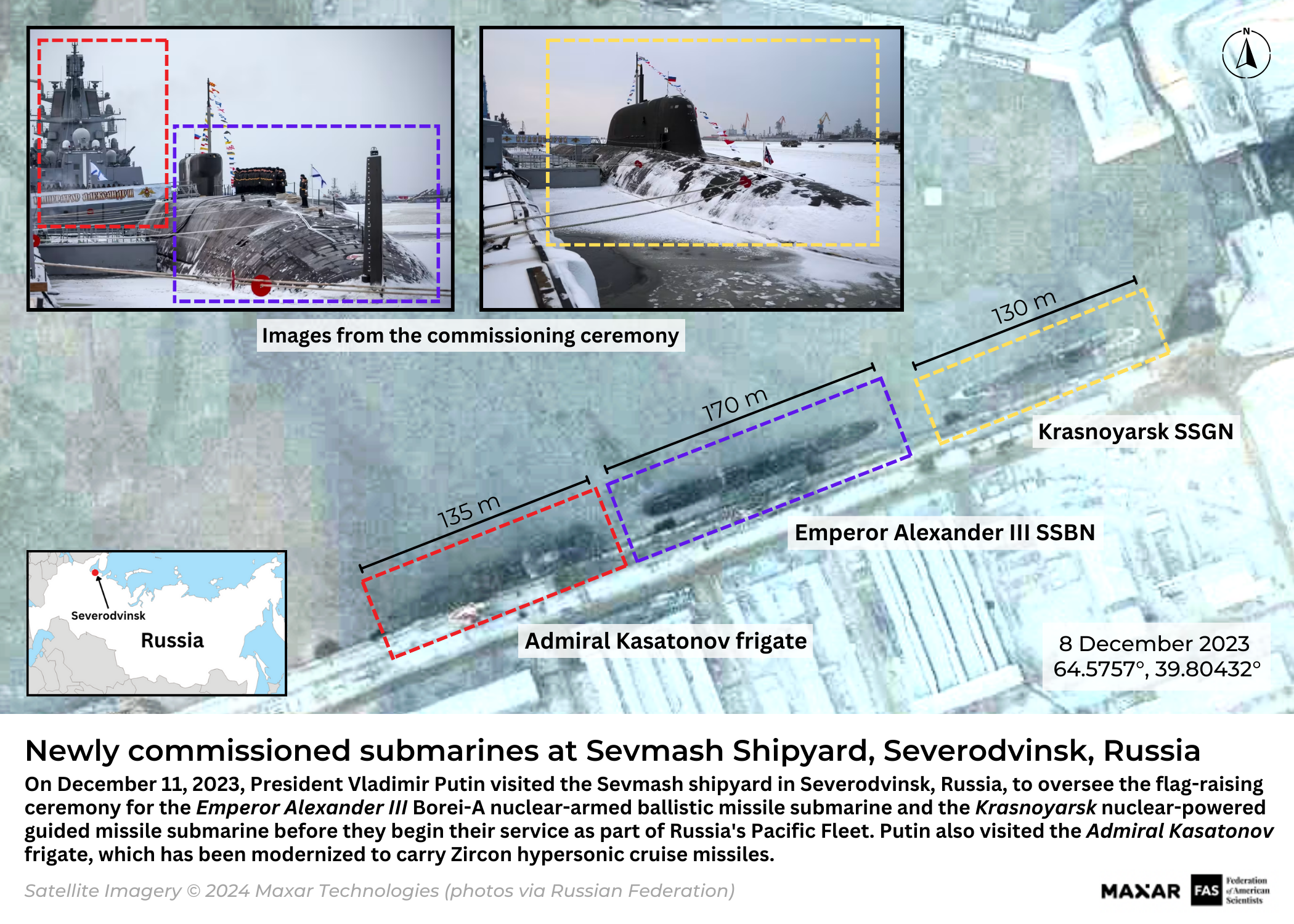
On December 11, 2023, President Vladimir Putin visited the Sevmash shipyard in Severodvinsk, Russia, to oversee the flag-raising ceremony for the Emperor Alexander III Borei-A nuclear-armed ballistic missile submarine and the Krasnoyarsk nuclear-powered guided missile submarine before they begin their service as part of Russia’s Pacific Fleet. Putin also visited the Admiral Kasatonov frigate, which has been modernized to carry Zircon hypersonic cruise missiles.
Unlike many other nuclear–armed states, it is not unusual for Putin to oversee ceremonies or drills relating to Russia’s nuclear forces. He regularly attends flag-raising ceremonies of other nuclear-powered submarines and nuclear force exercises as a signal of strength and confidence in Russian nuclear capabilities. In fact, Kremlin Spokesman Dmitry Peskov stated before a February 2022 strategic deterrence force drill that “such drills and training launches, naturally, can’t be held without the head of state,” referring to Putin’s observance of the exercise.
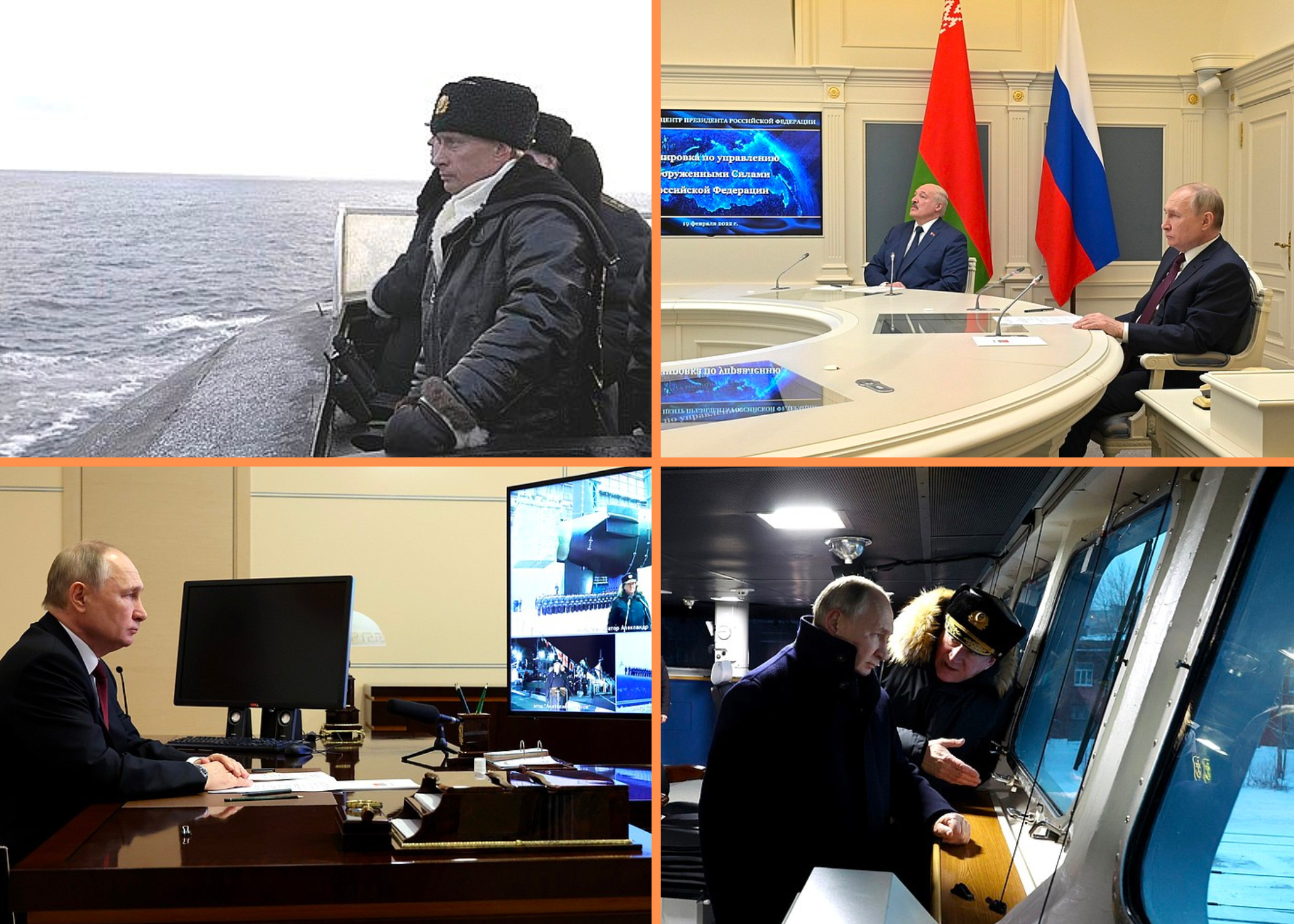
TOP LEFT: Putin views a strategic command post exercise in the Barents Sea in 2004. TOP RIGHT: Putin and President Belarus Lukashenko observe a February 2022 strategic deterrence forces exercise. BOTTOM LEFT: Putin attends a ceremony in December 2022 to raise the flag on the Generalissimus Suvorov SSBN and launch the Emperor Aleksandr III SSBN. BOTTOM RIGHT: Putin observes the frigate Admiral Kasatonov during the December 2023 commissioning ceremony of the Emperor Aleksandr III ballistic missile submarine and the Krasnoyarsk guided missile submarine.
While it is common for Putin to observe Russian nuclear force exercises and activities, this practice is not as customary in other nuclear-armed states. Leaders of other states will occasionally attend ceremonies or military parades that feature nuclear-capable weapons as a sign of power, but aside from in North Korea, heads of state do not regularly oversee nuclear weapons testing, exercises, and other related activities in person. Putin’s practice of uniquely observing these nuclear force drills or the commissioning of strategic weapons is presumably intended to signal the centrality of Russia’s nuclear weapons in its military doctrine.
Russian submarine fleet modernization
Submarines play a key role in Russia’s deterrence strategy, given that their stealth and survivability provide an important second-strike capability. The recent commissioning of new nuclear-powered submarines into the Pacific Fleet is a part of a larger modernization campaign as Russia’s older submarines begin to reach the ends of their service lives.
The Russian Navy currently operates two classes of SSBNs: five Delta IV (Project 667BRDM Delfin) and eight Borei (Project 955/A), five of which are the improved Borei-A (Project 955A) variant. The Emperor Alexander III––the submarine that Putin observed in December––is the seventh Borei-class submarine to enter service and the fourth of the upgraded Borei-A type. The Emperor Alexander III will be based with the Pacific Fleet located in the Kamchatka Peninsula.
Two additional Borei-A SSBNs are currently under construction, and two more are thought to be in the planning stages. Eventually, it is expected that six Borei SSBNs will be assigned to the Northern Fleet based in the Kola Peninsula, and six will be assigned to the Pacific Fleet. The new generation of Borei SSBNs will replace the Soviet-era Delta IV submarines, which are scheduled to be decommissioned throughout the late-2020s and early-2030s.
Each Borei submarine is capable of carrying 16 Bulava (SS-N-32) submarine-launched ballistic missiles (SLBMs), which can carry up to six warheads each. However, it is likely that each missile has been downloaded to four warheads to comply with the New START limit on deployed strategic warheads. Although President Putin “suspended” Russia’s participation in New START in February 2023, Russian officials subsequently stated that Russia would continue to abide by the treaty’s central limits; if so, these SLBMs presumably still carry a reduced number of warheads. This limit falls away when the New START treaty expires in February 2026 unless it is replaced with a new agreement.
A possible next generation Russian strategic nuclear submarines concept – known as “Arktur” or “Arcturus” – was unveiled at the “Army 2022” International Military-Technical Forum and could potentially start replacing the Borei-class submarines sometime after 2037. Notably, an industry official said the Arktur-class will be smaller than the current Borei-class and have a reduced number of ballistic missiles. The design concept appears to allow the submarine to also carry other weapons as well as an unmanned underwater vehicle, which would imply a multi-mission role. New SSBN variants will also likely be equipped with reactor technology that extends the amount of time required between refueling, which will significantly shorten midlife maintenance operations and allow for more submarines to be on patrol at the same point in time.

In addition to strategic SSBNs, the Russian Navy operates sea-based nonstrategic nuclear weapons, including land-attack cruise missiles, anti-ship cruise missiles, torpedoes, and more, which can be launched from naval systems such as aircraft carriers, cruisers, frigates, corvettes, naval aircraft, and guided missile submarines such as the Krasnoyarsk––the other submarine that Putin observed in December.
The Russian Navy is also building submarines specially configured to carry a new nuclear-powered, long-range, nuclear-armed torpedo called Poseidon. The first of these submarines—Project 09852 Belgorod (K-329)—was delivered to the Russian Navy in July 2022 and reportedly will be capable of carrying up to six Poseidon torpedoes. The second submarine—Project 09851 Khabarovsk—is in the final stages of construction at the Sevmash Shipyard and will also reportedly carry up to six Poseidon torpedoes. One more specially configured submarine is planned to be delivered to the Russian Navy by 2027, for a total of at least three Poseidon-capable submarines.
Upgrades to Pacific Fleet infrastructure
A new division of specially configured submarines will reportedly be stationed with the Pacific fleet by the end of 2025. To support this expansion, as well as the additions of the Krasnoyarsk, Emperor Alexander III, and eventually more Borei submarines, infrastructure at the Pacific Fleet naval base in Kamchatka is undergoing significant renovations. In the past several years, Russia has added additional storage at the missile and warhead depots and begun construction of a new pier. These projects can be seen from satellite imagery captured by Planet Labs PBC.
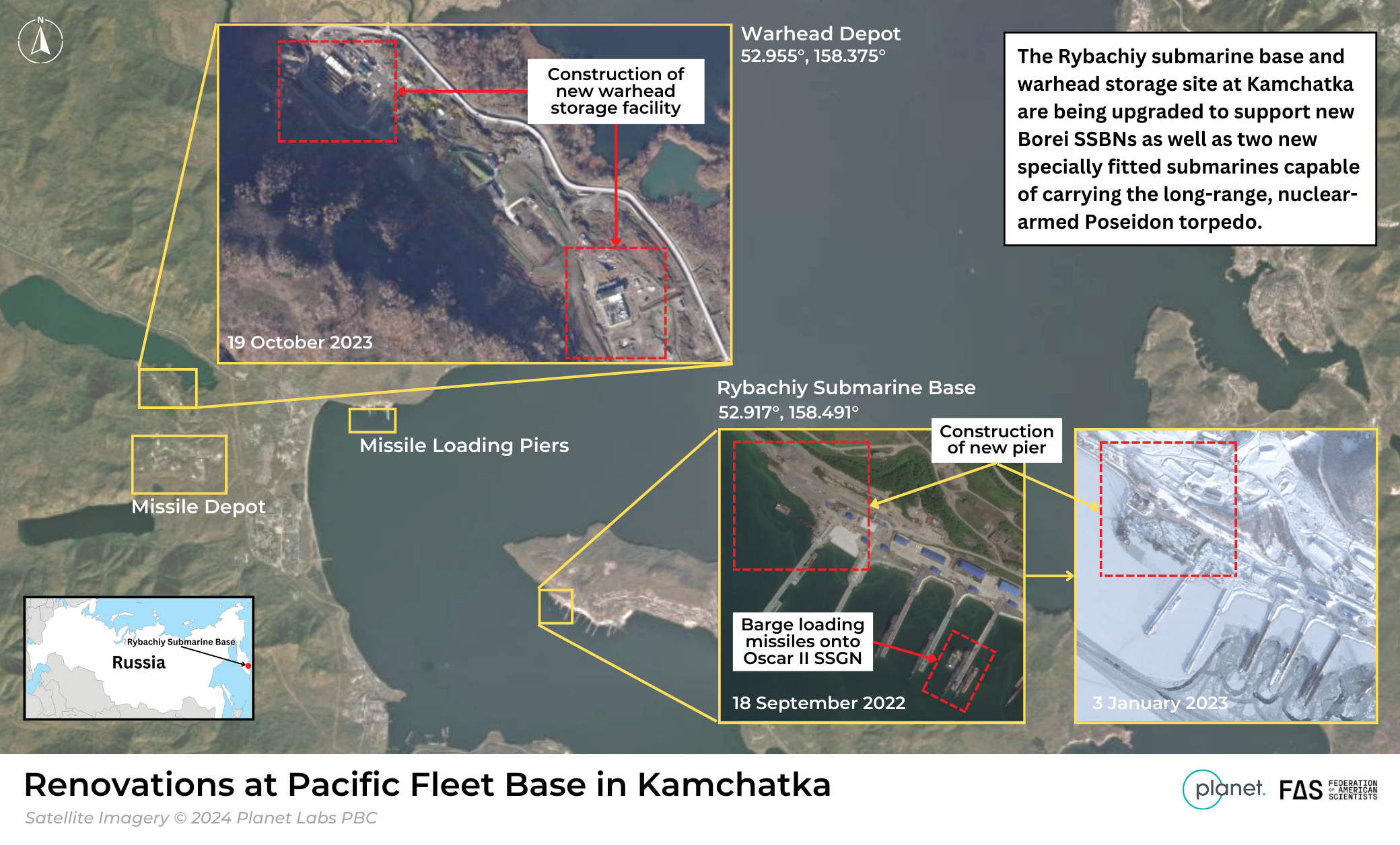
The Rybachiy submarine base and warhead storage site at Kamchatka are being upgraded to support new Borei SSBNs as well as two new specially fitted submarines capable of carrying the long-range, nuclear-armed Poseidon torpedo.
While upgrades to the existing warhead storage facilities at the Rybachiy submarine base in Kamchatka began sometime after August 2013, construction of a new underground warhead storage facility began in early 2020 and is ongoing. The existing storage facility was built to accommodate warheads for now-decommissioned Delta III submarines, but those missiles could only carry three warheads on each missile. Since the new Borei SSBNs will be able to carry up to six warheads on each of its 16 SLBMs, the new facilities are likely meant for the Pacific Fleet to accommodate additional warheads as Russia completes the modernization of the submarine fleet in the coming years.
This new storage addition is also particularly interesting because of its unique design – the facility has a different layout than existing Russian naval warhead storage facilities in the Pacific and Northern Fleets and seems to be designed similarly to what the U.S. Navy has built for its Pacific SSBN fleet.
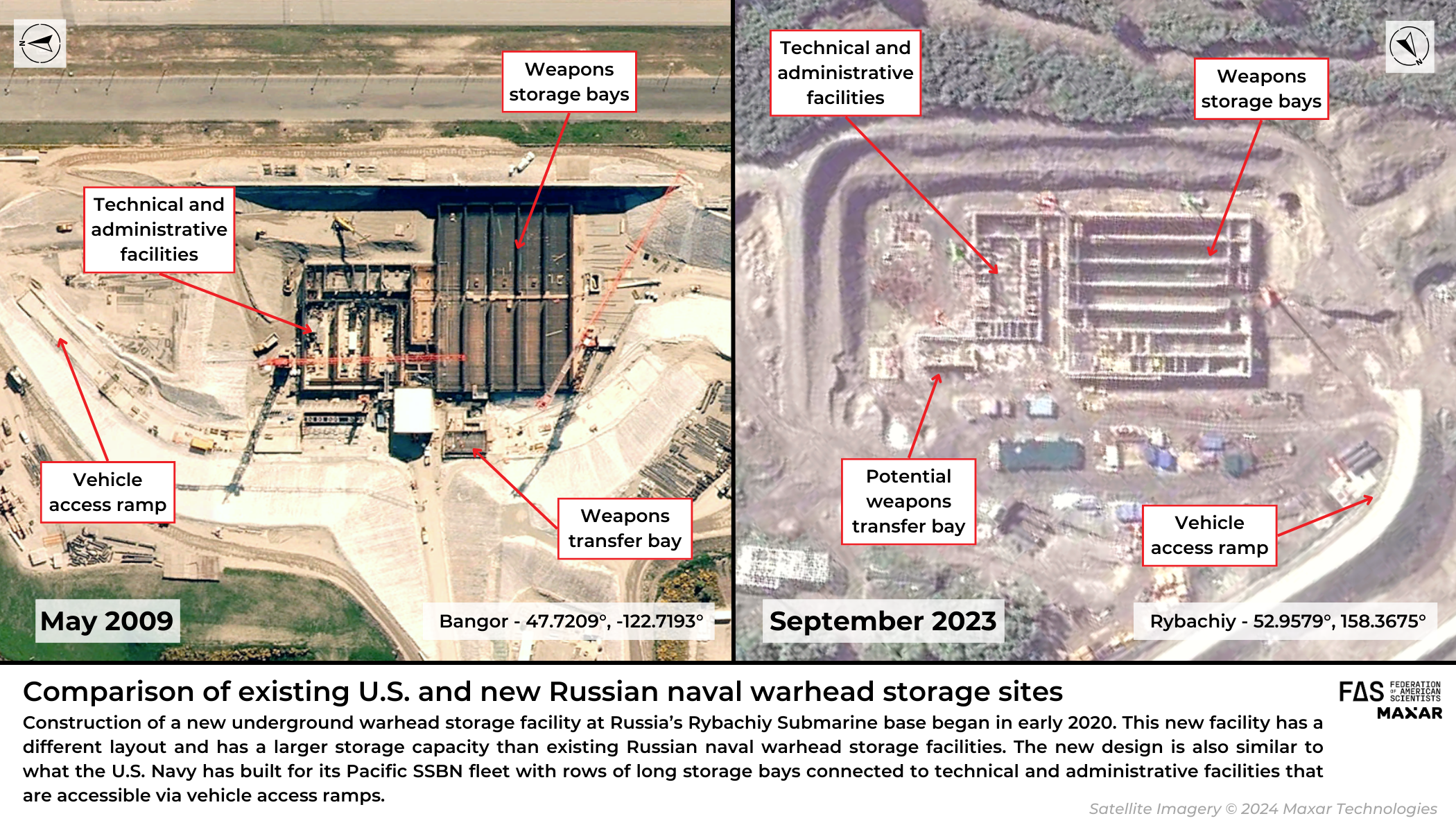
Construction of a new underground warhead storage facility at Russia’s Rybachiy Submarine base began in early 2020. This new facility has a different layout and has a larger storage capacity than existing Russian naval warhead storage facilities. The new design is also similar to what the U.S. Navy has built for its Pacific SSBN fleet with rows of long storage bays connected to technical and administrative facilities that are accessible via vehicle access ramps.
This research was carried out with generous contributions from the New-Land Foundation, Ploughshares Fund, the Prospect Hill Foundation, Longview Philanthropy, and individual donors.
Upgrade Underway for Russian Silos to Receive New Sarmat ICBM
New satellite imagery shows that preparations to deploy Russia’s new RS-28 Sarmat (SS-29) intercontinental ballistic missile (ICBM) are well underway.
However, the imagery also indicates that President Putin’s claims of deployment “in the near future” may be too optimistic. It is potentially possible that one or two missiles could be deployed early, but major construction is still ongoing at many of the silos in the first regiment and has not yet begun at all of them, and the completion of construction at all eventual Sarmat regiments may be over a decade away.
The Sarmat––which was originally scheduled to enter service between 2018 and 2020 and will replace Russia’s aging RS-20V Voevoda (SS-18) ICBM––had been subject to significant manufacturing, production, and testing delays. In January 2022, the “War Bolts” Telegram channel reported that flight tests for Sarmat had been postponed due to problems with the missile’s command module. Following Sarmat’s eventual first test flight on 20 April 2022, Putin announced that the new ICBM would enter combat duty by the end of the year. As of October 2023, however, only one additional Sarmat flight test had reportedly taken place (in February 2023) and, according to US officials, likely ended in failure.
Despite the lack of successful tests, in November 2022 the General Director of the Makeyev Rocket Design Bureau––responsible for the design of Sarmat––claimed that the missile had already entered serial production. On 1 September 2023, Roscosmos Chief Yury Borisov announced that Sarmat had “assumed combat alert posture,” although this was likely premature: on 5 October 2023, President Putin noted during his speech at the Valdai Club that some “administrative and bureaucratic procedures” still needed to be carried out before Sarmat could be placed on combat duty, and on 7 October 2023, the Russian Ministry of Defence noted on Telegram that the “final stages” of construction and installation were still underway at the first launch facilities and associated command post.
New satellite imagery indicates construction is well underway at the first regiment of the 62nd Missile Division near Uzhur in south Siberia. It is expected that a total of 46 Sarmat missiles will eventually be deployed with seven regiments (six missiles per regiment, plus one 10-missile regiment) in two divisions at Uzhur and Dombarovsky.
The first missile regiment undergoing its upgrade to Sarmat is the 302nd Missile Regiment and consists of six silos. Major construction continues at the launch control center and its accompanying silo (12C) and three other silos (13C, 15C, and 17C). The two remaining silos (16C and 18C) have only received minor upgrades and will take many months to complete if scheduled for the same comprehensive upgrade as the other silos.
Silos 12C and 17C:
The first two silos to begin their upgrades were Silos 12C (55.1144°, 89.6344°) and 17C (55.0347°, 89.7286°), which began their upgrades in the spring and summer of 2021, respectively. Over the past two years, the perimeters at both sites were removed, reshaped, and expanded with additional layers of fencing. The surface area of both silos has nearly doubled in size: Silo 12C has been expanded from approximately 0.228 square kilometers to 0.427 square kilometers, and the area of Silo 17C has been expanded from approximately 0.082 square kilometers to 0.136 square kilometers.

As of mid-September, construction appeared to be nearly complete inside the inner silo areas at both sites. The launch control center at Silo 12C has been upgraded to a newer LCC design that can also be seen at other Russian ICBM complexes, including the SS-27 Mod 1 “Topol-M” silo field near Tatishchevo, the SS-27 Mod 2 “Yars” silo field near Kozelsk, and the SS-19 Mod 4 “Avangard” silo field near Dombarovsky. In addition, Silo 12C boasts a new gun turret placement and expanded administrative area, although this outer area is not yet complete.
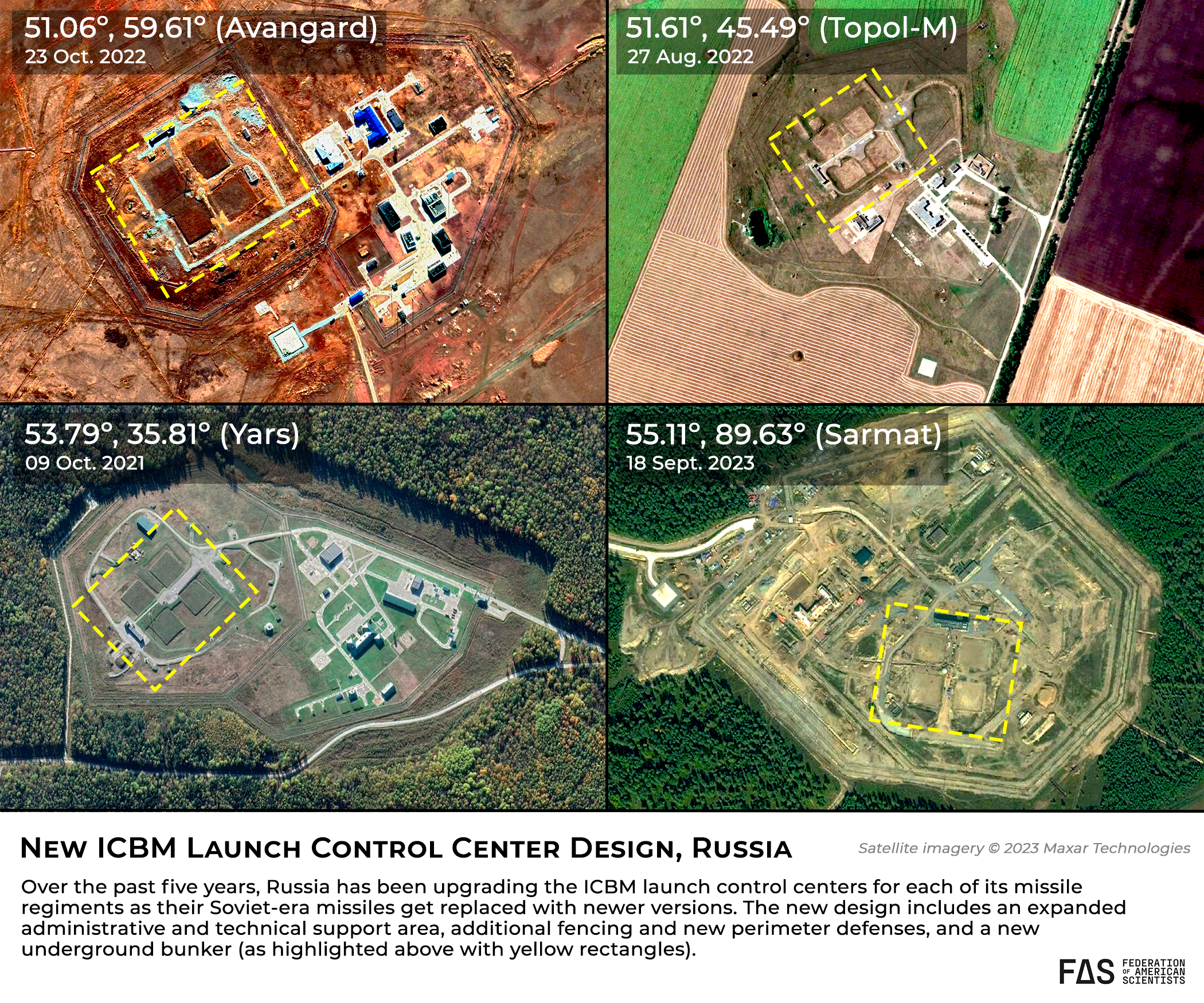
Notably, the immediate area surrounding Silo 17C has been subject to significant wildfire damage in the past. In 2017, a wildfire burned through all three sets of perimeter fencing and damaged the inner road leading to the silo hatch. In May 2021, another wildfire again burned through the three layers of fencing and appeared to damage an administrative building near the hatch.
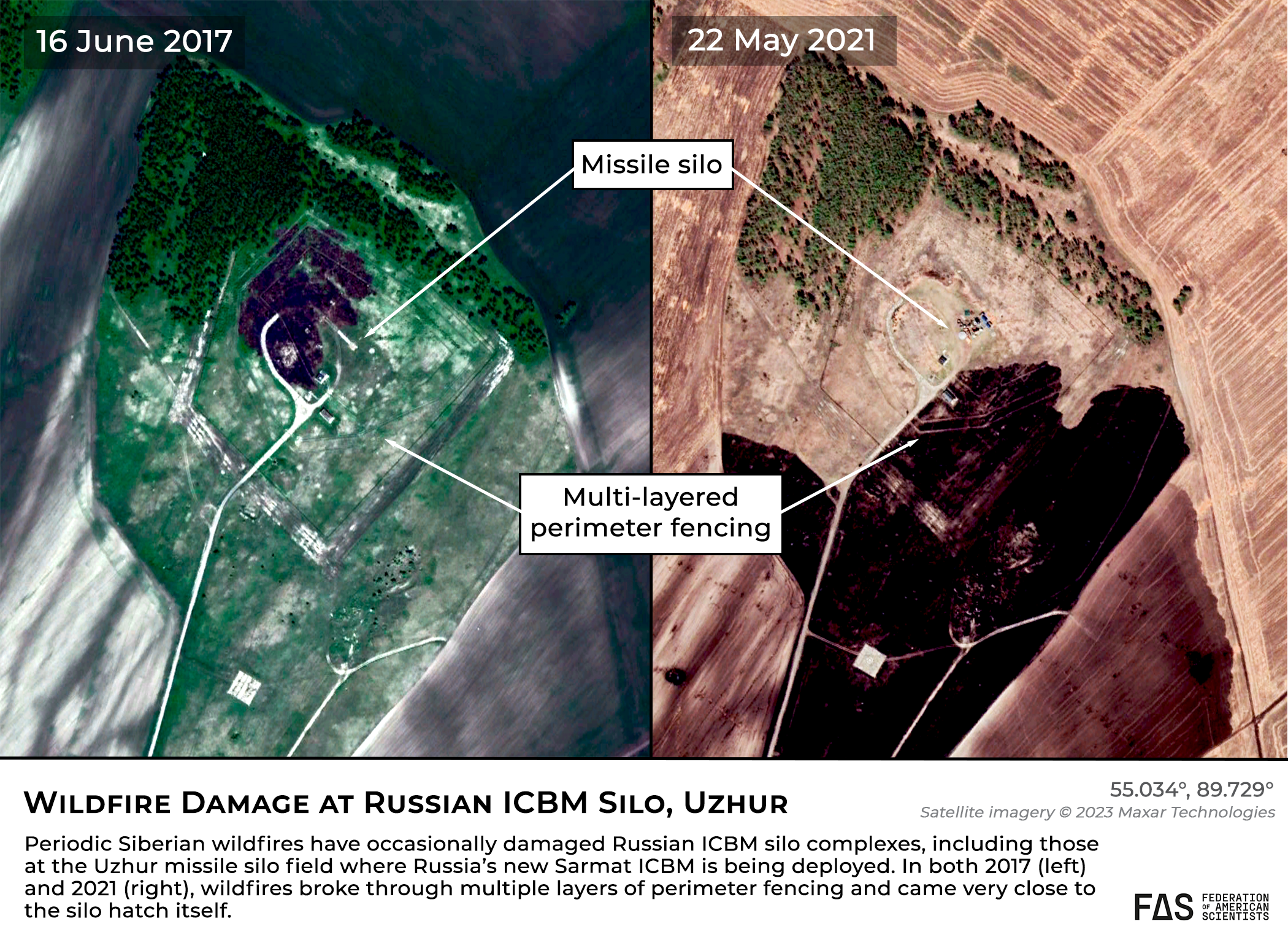
Silos 13C and 15C:
Silos 13C (55.2008°, 89.7061°) and 17C (55.0822°, 89.8155°) began their upgrades in late-2022, nearly 1.5 years after construction on the first two silos began. As of mid-October 2023, significant construction at both sites was still underway, including underground and inside the silos themselves. Trees have been removed at both sites to make space for the expanded perimeter fences. While the new perimeters at both sites have been marked out, the multiple layers of fencing have not yet been completed. New gun turrets at both sites now appear to be in place.

Use the Planet Labs PBC interactive slider to compare before/after images.
Silos 16C and 18C:
As of mid-September 2023, full-site construction at Silos 16C (55.0247º, 89.5711º) and 18C (54.9501º, 89.6833º) had not yet begun, although some silo maintenance work has been visible since mid-2021, possibly in preparation for the full-site construction.
Open silos
It is notable that satellites have managed to capture images of all four silos currently under construction with their hatches open; on more than one occasion, multiple different silos could be seen with their hatches open on the same day, and in some cases hatches have stayed open for days at a time. This suggests that operations to upgrade the silos themselves and preparations to deploy Sarmat ICBMs inside them––as touted by high-ranking Russian officials––are well underway.

Additional information:
• Nuclear Notebook: Russian Nuclear Weapons, 2023
This research was carried out with generous contributions from the New-Land Foundation, Ploughshares Fund, the Prospect Hill Foundation, Longview Philanthropy, and individual donors.
Strategic Posture Commission Report Calls for Broad Nuclear Buildup
On October 12th, the Strategic Posture Commission released its long-awaited report on U.S. nuclear policy and strategic stability. The 12-member Commission was hand-picked by Congress in 2022 to conduct a threat assessment, consider alterations to U.S. force posture, and provide recommendations.
In contrast to the Biden administration’s Nuclear Posture Review, the Congressionally-mandated Strategic Posture Commission report is a full-throated embrace of a U.S. nuclear build-up.
It includes recommendations for the United States to prepare to increase its number of deployed warheads, as well as increasing its production of bombers, air-launched cruise missiles, ballistic missile submarines, non-strategic nuclear forces, and warhead production capacity. It also calls for the United States to deploy multiple warheads on land-based intercontinental ballistic missiles (ICBMs) and consider adding road-mobile ICBMs to its arsenal.
The only thing that appears to have prevented the Commission from recommending an immediate increase of the U.S. nuclear weapons stockpile is that the weapons production complex currently does not have the capacity to do so.
The Commission’s embrace of a U.S. nuclear buildup ignores the consequences of a likely arms race with Russia and China (in fact, the Commission doesn’t even consider this or suggest other steps than a buildup to try to address the problem). If the United States responds to the Chinese buildup by increasing its own deployed warheads and launchers, Russia would most likely respond by increasing its deployed warheads and launchers. That would increase the nuclear threat against the United States and its allies. China, who has already decided that it needs more nuclear weapons to stand up to the existing U.S. force level (and those of Russia and India), might well respond to the U.S and Russian increases by increasing its own arsenal even further. That would put the United States back to where it started, feeling insufficient and facing increased nuclear threats.
Framing and context
The Commission’s report is generally framed around the prospect of Russian and Chinese strategic military cooperation against the United States. The Commission cautions against “dismissing the possibility of opportunistic or simultaneous two-peer aggression because it may seem improbable,” and notes that “not addressing it in U.S. strategy and strategic posture, could have the perverse effect of making such aggression more likely.” The Commission does not acknowledge, however, that building up new capabilities to address this highly remote possibility would likely kick the arms race into an even higher gear.
The report acknowledges that Russia and China are in the midst of large-scale modernization programs, and in the case of China, significant increases to its nuclear stockpile. This accords with our own assessments of both countries’ nuclear programs. However, the report’s authors suggest that these changes fundamentally call into question the United States’ assured retaliatory capabilities, and state that “the current U.S. strategic posture will be insufficient to achieve the objectives of U.S. defense strategy in the future….”
The Commission appears to base this conclusion, as well as its nuclear strategy and force structure recommendations, squarely on numerically-focused counterforce thinking: if China increases its posture by fielding more weapons, that automatically means the United States needs more weapons to “[a]ddress the larger number of targets….” However, the survivability of the US ballistic missile submarines should insulate the United States against needing to subscribe to this kind of thinking.
In 2012, a joint DOD/DNI report acknowledged that because of the US submarine force, Russia would not achieve any military advantage against the United States by significantly increasing the size of its deployed nuclear forces. In that 2012 study, both departments concluded that the “Russian Federation…would not be able to achieve a militarily significant advantage by any plausible expansion of its strategic nuclear forces, even in a cheating or breakout scenario under the New START Treaty, primarily because of the inherent survivability of the planned U.S. Strategic force structure, particularly the OHIO-class ballistic missile submarines, a number of which are at sea at any given time.” [Emphasis added.] Why would this logic not apply to China as well? Although China’s nuclear arsenal is undoubtedly growing, why would it fundamentally alter the nature of the United States’ assured retaliatory capability while the United States is confident in the survivability of its SSBNs?
In this context, it is worth reiterating the words of Secretary of Defense Lloyd Austin at the U.S. Strategic Command Change of Command Ceremony: “We all understand that nuclear deterrence isn’t just a numbers game. In fact, that sort of thinking can spur a dangerous arms race…deterrence has never been just about the numbers, the weapons, or the platforms.”
Force structure
Although the report says the Commission “avoided making specific force structure recommendations” in order to “leave specific material solution decisions to the Executive Branch and Congress,” the list of “identified capabilities beyond the existing program of record (POR) that will be needed” leaves little doubt about what the Commission believes those force structure decisions should be.
Strategic posture alterations
The Commission concludes that the United States “must act now to pursue additional measures and programs…beyond the planned modernization of strategic delivery vehicles and warheads may include either or both qualitative and quantitative adjustments in the U.S. strategic posture.”
Specifically, the Commission recommends that the United States should pursue the following modifications to its strategic nuclear force posture “with urgency:” [our context and commentary added below]
- Prepare to upload some or all of the nation’s hedge warheads; [these warheads are currently in storage; increasing deployed warheads above 1,550 is prohibited by the New START treaty (which expires in early-2026) and would likely cause Russia to also increase its deployed warheads.]
- Plan to deploy the Sentinel ICBM in a MIRVed configuration; [the Sentinel appears to be capable of carrying two MIRV but current plan calls for each missile to be deployed with just a single warhead]
- Increase the planned number of deployed Long-Range Standoff Weapons; [the Air Force currently has just over 500 ALCMs and plans to build 1,087 LRSOs (including test-flight missiles), each of which costs approximately $13 million]
- Increase the planned number of B-21 bombers and the tankers an expanded force would require; [the Air Force has said that it plans to purchase at least 100 B-21s]
- Increase the planned production of Columbia SSBNs and their Trident ballistic missile systems, and accelerate development and deployment of D5LE2; [the Navy currently plans to build 12 Columbia-class SSBNs and an increase would not happen until after the 12th SSBN is completed in the 2040s]
- Pursue the feasibility of fielding some portion of the future ICBM force in a road mobile configuration; [historically, any efforts to deploy road-mobile ICBMs in the United States have been unsuccessful]
- Accelerate efforts to develop advanced countermeasures to adversary IAMD; and
- Initiate planning and preparations for a portion of the future bomber fleet to be on continuous alert status, in time for the B-21 Full Operational Capability (FOC) date.” [Bombers currently regularly practice loading nuclear weapons as part of rapid-takeoff exercises. Returning bombers to alert would revert the decision by President H.W. Bush in 1991 to take bombers off alert. In 2021, the Air Force’s Deputy Chief of Staff for Strategic Deterrence and Nuclear Integration stated that keeping the bomber fleet on continuous alert would exhaust the force and could not be done indefinitely]
Nonstrategic posture alterations
The Commission appears to want the United States to bolster its non-strategic nuclear forces in Europe, and begin to deploy non-strategic nuclear weapons in the Indo-Pacific theater: “Additional U.S. theater nuclear capabilities will be necessary in both Europe and the Indo-Pacific regions to deter adversary nuclear use and offset local conventional superiority. These additional theater capabilities will need to be deployable, survivable, and variable in their available yield options.” Although the Commission does not explicitly recommend fielding either ground-launched theater nuclear capabilities or a nuclear sea-launched cruise missile for the Navy, it seems clear that these capabilities would be part of the Commission’s logic.
The United States used to deploy large numbers of non-strategic nuclear weapons in the Indo-Pacific region during the Cold War, but those weapons were withdrawn in the early 1990s and later dismantled as U.S. military planning shifted to rely more on advanced conventional weapons for limited theater options. Despite the removal of certain types of theater nuclear weapons after the Cold War, today the President maintains a wide range of nuclear response options designed to deter Russian and Chinese limited nuclear use in both regions––including capabilities with low or variable yields. In addition to ballistic missile submarines and nuclear-capable bombers operating in both regions, the U.S. Air Force has non-strategic B61 nuclear bombs for dual-capable aircraft that are intended for operations in both regions if it becomes necessary. The Navy now also has a low-yield warhead on its SSBNs––the W76-2––that was fielded specifically to provide the President with more options to deter limited scenarios in those regions. It is unclear why these existing options, as well as several additional capabilities already under development––including the incoming Long-Range Stand-Off Weapon––would be insufficient for maintaining regional deterrence.
The Commission specifically recommends that the United States should “urgently” modify its nuclear posture to “[p]rovide the President a range of militarily effective nuclear response options to deter or counter Russian or Chinese limited nuclear use in theater.” Although current plans already provide the President with such options, the Commission “recommends the following U.S. theater nuclear force posture modifications:
Develop and deploy theater nuclear delivery systems that have some or all of the following attributes: [our context and commentary added below]
- Forward-deployed or deployable in the European and Asia-Pacific theaters [The United States already has dual-capable fighters and B61 bombs earmarked for operations in the Asia-Pacific theaters, backed up by bombers with long-range cruise missiles];
- Survivable against preemptive attack without force generation day-to-day;
- A range of explosive yield options, including low yield [US nuclear forces earmarked for regional options already have a wide range of low-yield options];
- Capable of penetrating advanced IAMD with high confidence [F-35A dual-capable aircraft, the B-21 bomber, and air-launched cruise missiles are already being developed with enhanced penetration capabilities]; and
- Operationally relevant weapon delivery timeline (promptness) [the US recently fielded the W76-2 warhead on SSBNs to provide prompt theater capability in limited scenarios and is developing new prompt conventional missiles].”
Unlike U.S. low-yield theater nuclear weapons, the Commission warns that China’s development of “theater-range low-yield weapons may reduce China’s threshold for using nuclear weapons.” Presumably, the same would be true for the United States threshold if it followed the Commission’s recommendation to increase deployed (or deployable) non-strategic nuclear weapons with low-yield capabilities in the Indo-Pacific theater.
Strategy
Overall, the Commission suggests that current U.S. nuclear strategy is basically sound, but just needs to be backed up with additional weapons and industrial capacity. However, by not including recommendations to modify presidential nuclear employment guidance –– or even considering such an adjustment, which could reshape U.S. force posture to allow for decreased emphasis on counterforce targeting –– the Commission has limited its own flexibility to recommend any options other than simply adding more weapons.
Three scholars recently proposed a revised nuclear strategy that they concluded would reduce weapons requirements yet still be sufficient to adequately deter Russia and China. The central premise of reducing the counterforce focus is similar to a study that we published in 2009. In contrast, the Commission appears to have assumed an unchanged nuclear strategy and instead focused intensely on weapons and numbers.
The Commission report does not explain how it gets to the specific nuclear arms additions it says are needed. It only provides generic descriptions of nuclear strategy and lists of Chinese and Russian increases. The reason this translates into a recommendation to increase the US nuclear arsenal appears to be that the list of target categories that the Commission believes need to be targeted is very broad: “this means holding at risk key elements of their leadership, the security structure maintaining the leadership in power, their nuclear and conventional forces, and their war supporting industry.”
This numerical focus also ignores years of adjustments made to nuclear planning intended to avoid excessive nuclear force levels and increase flexibility. When asked in 2017 whether the US needed new nuclear capabilities for limited scenarios, then STRATCOM commander General John Hyten responded:
“[W]e actually have very flexible options in our plans. So if something bad happens in the world and there’s a response and I’m on the phone with the Secretary of Defense and the President and the entire staff, …I actually have a series of very flexible options from conventional all the way up to large-scale nuke that I can advise the President on to give him options on what he would want to do… So I’m very comfortable today with the flexibility of our response options… And the reason I was surprised when I got to STRATCOM about the flexibility, is because the last time I executed or was involved in the execution of the nuclear plan was about 20 years ago and there was no flexibility in the plan. It was big, it was huge, it was massively destructive, and that’s all there. We now have conventional responses all the way up to the nuclear responses, and I think that’s a very healthy thing.”
While advocating integrated deterrence and a “whole of government” approach, the Commission nonetheless sets up an artificial dichotomy between conventional and nuclear capabilities: “The objectives of U.S. strategy must include effective deterrence and defeat of simultaneous Russian and Chinese aggression in Europe and Asia using conventional forces. If the United States and its Allies and partners do not field sufficient conventional forces to achieve this objective, U.S. strategy would need to be altered to increase reliance on nuclear weapons to deter or counter opportunistic or collaborative aggression in the other theater.”
Arms control
The Commission recommends subjugating nuclear arms control to the nuclear build-up: “The Commission recommends that a strategy to address the two-nuclear-peer threat environment be a prerequisite for developing U.S. nuclear arms control limits for the 2027-2035 timeframe. The Commission recommends that once a strategy and its related force requirements are established, the U.S. government determine whether and how nuclear arms control limits continue to enhance U.S. security.”
Put another way, this constitutes a recommendation to participate in an arms race, and then figure out how to control those same arms later.
The Commission report does acknowledge the importance of arms control, and notes that “[t]he ideal scenario for the United States would be a trilateral agreement that could effectively verify and limit all Russian, Chinese, and U.S. nuclear warheads and delivery systems, while retaining sufficient U.S. nuclear forces to meet security objectives and hedge against potential violations of the agreement.” (p.85) However, the prospect of this “ideal scenario” coming true would become increasingly unlikely if the United States significantly built up its nuclear forces as the Commission recommends.
Capacity and budget
The Commission recommends an overhaul and expansion of the nuclear weapons design and production capacity. That includes full funding of all NNSA recapitalization efforts, including pit production plans, even though the Government Accountability Office has warned that the program faces serious challenges and budget uncertainties. The Commission appears to brush aside concerns about the proposed pit production program.
Overall, the report does not seem to acknowledge any limits to defense spending. Amid all of the Commission’s recommendations to increase the number of strategic and tactical nuclear systems, there is almost no mention of cost in the entire report. Fulfilling all of these recommendations would require a significant amount of money, and that money would have to come from somewhere.
For example, the Congressional Budget Office estimates that developing the SLCM-N alone would cost an estimated $10 billion until 2030, not to mention another $7 billion for other tactical nuclear weapons and delivery systems. The amount of money it would take to field new systems, in addition to addressing other vital concerns such as IAMD, means funding would necessarily be cut from other budget priorities.
The true costs of these systems are not only the significant funds spent to acquire them, but also the fact that prioritizing these systems necessarily means deprioritizing other domestic or foreign policy initiatives that could do more to increase US security.
Implications for U.S. Nuclear Posture
The Strategic Posture Commission report is, in effect, a congressionally-mandated rebuttal to the Biden administration’s Nuclear Posture Review, which many in Congress have critiqued for not being hawkish enough. The report does not describe in detail its methodology for how it arrives at its force buildup recommendations, and includes several claims and assumptions about nuclear strategy that have been critiqued and called into question by recent scholarship. In some respects, it reads more like an industry report than a Congressionally-mandated study.
While the timing of the report means that it is unlikely to have a significant impact on this year’s budget cycle, it will certainly play a critical role in justifying increases to the nuclear budget for years to come.
From our perspective, the recommendations included in the Commission report are likely to exacerbate the arms race, further constrict the window for engaging with Russia and China on arms control, and redirect funding away from more proximate priorities. At the very least, before embarking on this overambitious wish list the United States must address any outstanding recommendations from the Government Accountability Office to fix its planning and budgeting processes, otherwise it risks overloading the assembly line even more.
In addition, the United States could consider how modified presidential employment guidance might enable a posture that relies on fewer nuclear weapons, and adjust accordingly.
This research was carried out with generous contributions from the New-Land Foundation, Ploughshares Fund, the Prospect Hill Foundation, Longview Philanthropy, and individual donors.
Does Russia Have Nuclear Landmines?
Photos of Russian nuclear “backpacks” or landmines are hard to come by. For illustrative purposes, this is an image of a U.S. Special Atomic Demolition Munition (SADM) in its bag (since retired). The U.S. military possessed nuclear demolition weapons until the 1980s.
Last week, Reuters published a report that said the Wagner group rebellion that sent armed forces hundreds of miles across Russia got near a nuclear weapons storage site: Voronezh-45.
Kyrylo Budanov, the head of Ukraine’s military intelligence, reportedly said that the rebels reached the nuclear base and that their intention was to acquire small Soviet-era nuclear devices in order to “raise the stakes” in their mutiny.

Wagner rebels approached a Russian nuclear weapons storage site near Voronezh to get nuclear “backpacks,” Ukraine’s military intelligence chief claimed. The White House said it could not corroborate the claim.
A White House spokesperson said he could not corroborate the report and added that the United States “had no indication at any point that nuclear weapons or materials were at risk” during the Wagner event.
To help improve transparency on this issue, below we review what U.S. and NATO sources have stated recently about Russian nuclear landmines and non-strategic nuclear forces in general (for a more detailed overview of Russian nuclear forces, see our latest Nuclear Notebook).
Western Statements About Russian Nuclear Landmines
Whether or not the Wagner rebels got to or near a Russian nuclear weapons storage site (or what their intensions were), or whether nuclear weapons potentially stored there were at risk, the episode raises the question if Russia still has nuclear “backpacks” or landmines?
The answer appears to be yes – at least in some form. Recent U.S. Intelligence Community reports refer to them repeatedly, including a U.S. State Department report from 2023. But it is unclear what the status of the Russian landmines is: Are they part of the operational forces or leftovers from the Cold War in queue for dismantlement?
Before examining that question, it is useful to first review what U.S. and NATO sources have said about Russian landmines.
Refences to Soviet-era nuclear landmines can be found in many declassified Intelligence reports. One Central Intelligence Agency assessment from 1981 reported that the Soviet Union “may have introduced nuclear landmines” and a Defense Intelligence Agency guide reportedly listed them. But the wording in these reports were “may have” or “possibly have,” indicating a lower level of confidence. When the Soviet Union broke apart, the issue of “loose nukes” became a prominent concern – especially small weapons that could be easily transported. In a speech at the Stimson Center in 1994, for example, then US Defense Secretary William Perry expressed concern about the danger of loose tactical nuclear weapons in Russia, “such as nuclear artillery shells, land mines and others.” In 1997, Alexander Lebed, a former Russian general and advisor who had been fired by President Yeltsin, claimed Russia had lost track of 100 of 250 suitcase nuclear bombs. The U.S. Government and others questioned the claim and Lebed later withdrew his claim.
These were extraordinary claim for which no evidence was provided and Lebed later withdrew his claim. Yet the rumor that Russia has nuclear landmines has continued to percolate in the public debate and studies. The Trump administration’s Nuclear Posture Review from February 2018 did not list landmines in its overview of Russian non-strategic nuclear weapons. But the following year, one Pentagon official told Congress that the Russian non-strategic nuclear arsenal included “nuclear landmines, and nuclear artillery shells…” NATO appeared to pick up on that in its Annual Report from 2020 that listed both “landmines” and “artillery” (see image below). (It should be noted that neither the U.S. Department of State’s 2022 compliance report nor its 2023 non-strategic nuclear weapons report mentions nuclear artillery.)

NATO in 2020 listed both landmines and artillery in its overview of Russian nuclear forces.
References to Russian nuclear landmines have also appeared frequently in the U.S. State Department’s annual reports on arms control compliance. The report from 2020 listed “atomic demolition mines” as part of Russia’s “active” stockpile of non-strategic nuclear weapons. The 2021 report did not explicitly mention nuclear mines in the active stockpile, and the 2022 report changed the language slightly to the active stockpile “has also continue to include nuclear mines.”
The latest compliance report from 2023 does not include the usual large section on the Presidential Nuclear Initiatives and Russian non-strategic weapons. Instead, that section was moved into a special report on non-strategic nuclear weapons that Congress had requested as part of its approval of the New START treaty. That report, published in February 2023, reiterates that Russia’s “active” non-strategic nuclear stockpile incudes nuclear mines (see image below).
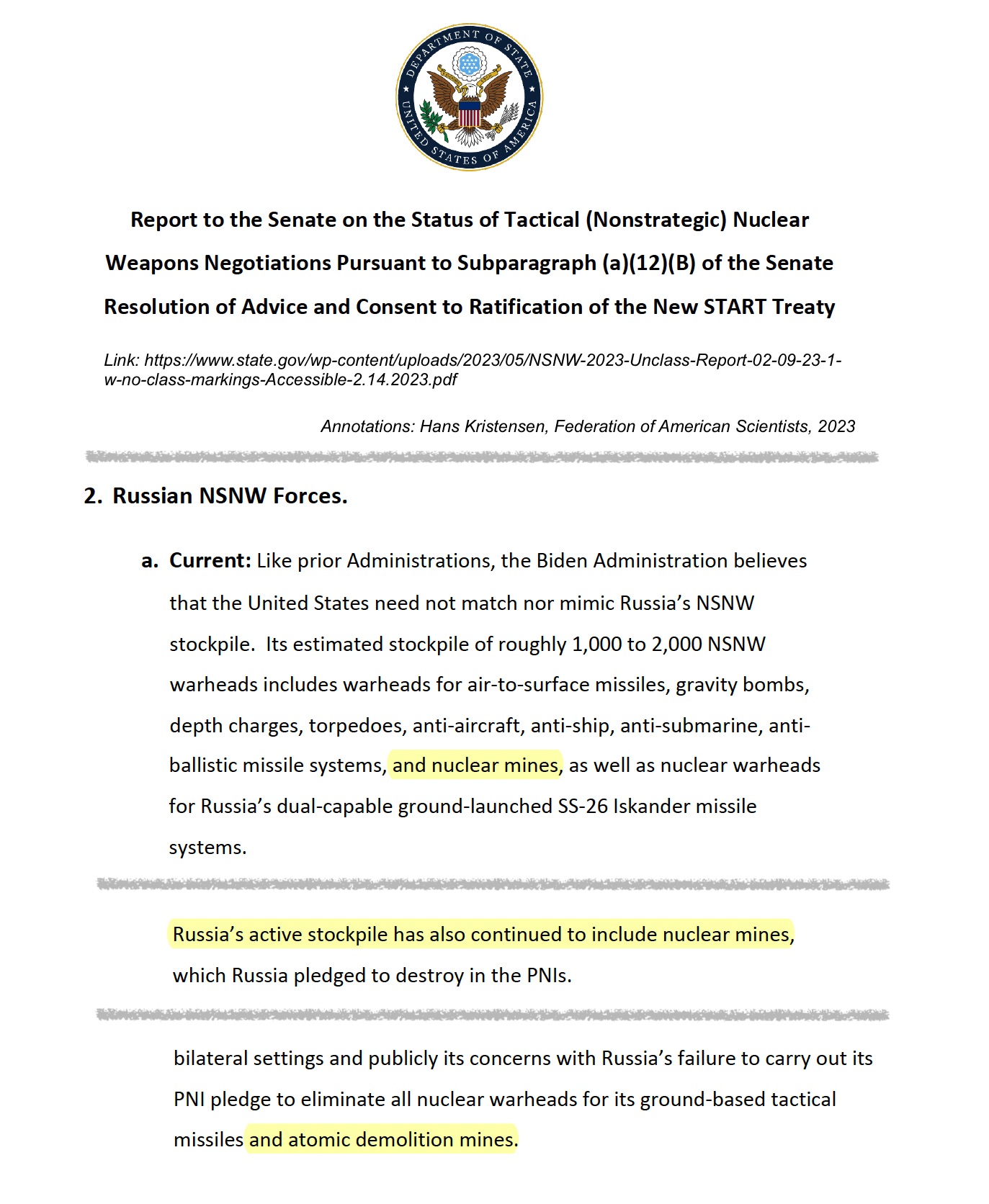
Recent U.S. Intelligence reports refer repeatedly to the existence of Russian nuclear landmines, although it is uncertain how operational they are. The reports do not refer to nuclear artillery.
Russian Non-Strategic Nuclear Weapons
The Trump administration’s Nuclear Posture Review in 2018 estimated that Russia had “up to 2,000” non-strategic nuclear weapons (this was close to the estimate we provided the same year). The NPR estimate was a significant reduction from the “3-5 thousand” Russian warheads listed by Principal Deputy Under Secretary of Defense for Policy James Miller in a briefing to NATO in 2009. Subsequent estimates published by the U.S. Intelligence Community (see above) indicate that the 2018 NPR number was at the high end of an estimated range of 1,000-2,000 warheads. Plotting these numbers from the much higher estimated inventory at the end of the Cold War shows this reduction of the Russian non-strategic nuclear weapons arsenal:
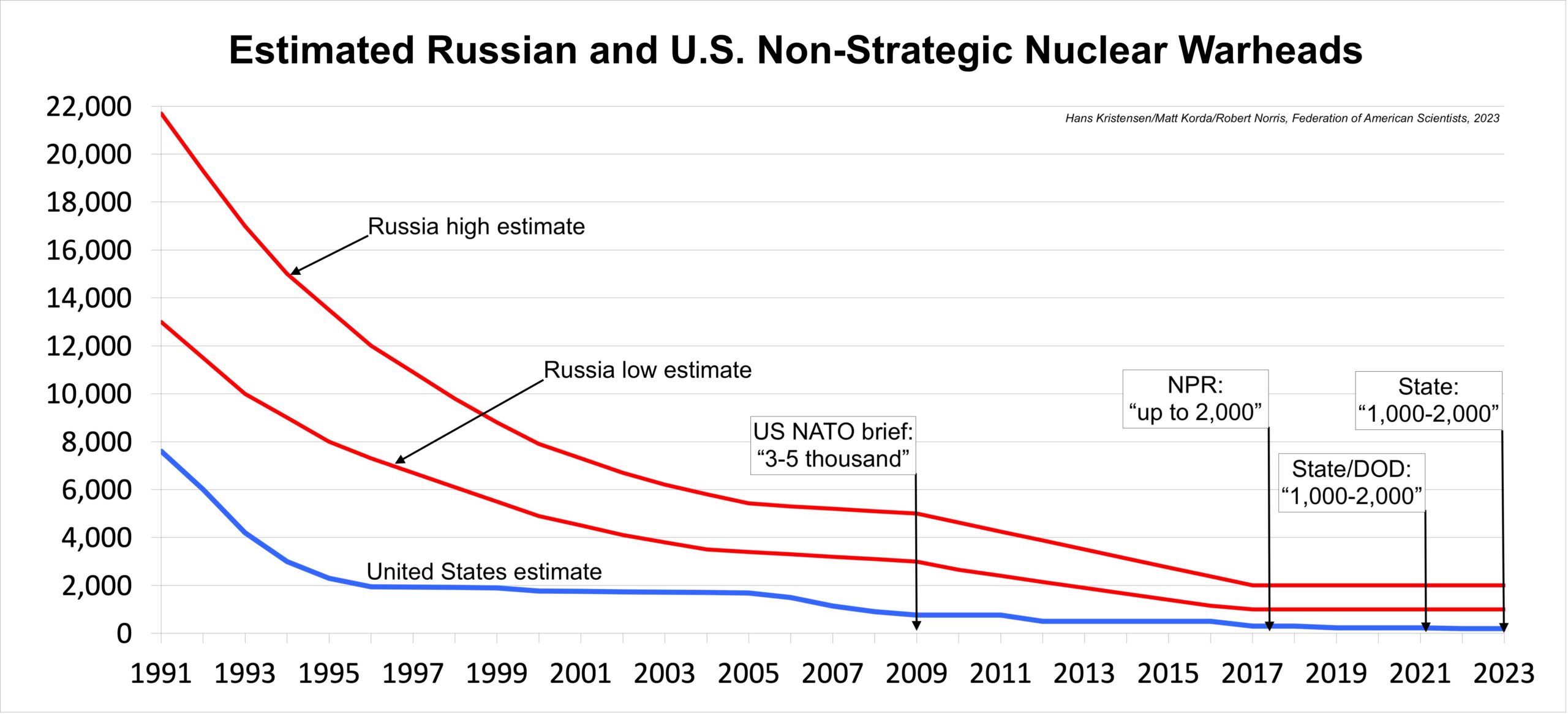
Russia’s stockpile of nuclear warheads for non-strategic forces has decreased significantly since the early-1990s – even during the past 15 years – and is estimated to be down to 1,000-2,000 warheads (including retired warheads awaiting dismantlement).
Interestingly, the U.S. State Department stated in 2022 that the Russian “active stockpile” of 1,000-2,000 non-strategic nuclear warheads included “warheads awaiting dismantlement…” This is curious because in the United States, warheads awaiting dismantlement are not considered “active” or part of an “active stockpile.” Rather, “active” warheads are part of the Department of Defense stockpile that includes both active and inactive warheads. “Active” warheads have all components installed; inactive warheads would need to have those components reinstalled first in order to be able to function.
This suggests that some of the Russian non-strategic warheads that are frequently portrayed in the public debate as part of the arsenal may in fact be retired warheads awaiting dismantlement. Although uncertain, nuclear landmines might be part of that inventory (nuclear artillery shells may be another part of the “awaiting dismantlement” inventory).
In addition to the uncertainty about the status of landmines in the Russian arsenal, advocates for modernization of the U.S. nuclear arsenal have claimed that Russian is expanding its non-strategic nuclear arsenal. Former STRATCOM commander Admiral Charles Richard told Congress in 2020 that “Russia’s overall nuclear stockpile is likely to grow significantly over the next decade – growth driven primarily by a projected increase in Russia’s non-strategic nuclear weapons.” (Emphasis added.)
The basis for that projection is unknown and uncertain. Russia is certainly modernizing its arsenal and fielding more types of weapons that the U.S. intelligence community claims are dual-capable. But how many of those launchers will actually be assigned nuclear warheads is another question. The latest U.S. State Department report acknowledges a Russian increase but cautions that “by how much is uncertain.”
Warhead projections are partially influenced by the expected growth of delivery platform deployments. But just because the number of dual-capable launchers in a weapons category is increasing doesn’t necessarily therefore mean that the number of warheads assigned to that weapons category is also increasing.
In the U.S. nuclear arsenal, for example, not all dual-capable F-15E and F-16 fighter-bombers are assigned nuclear weapons. And just because the F-35A Block 4 upgrade is intended to facilitate integration of nuclear technology, doesn’t therefore mean that all F-35A will be part of the nuclear posture and assigned nuclear weapons.
Simplistic dual-capable launcher counting as a basis for warhead projections could lead to exaggerated numbers.
So, there is much uncertainty about Russian non-strategic nuclear weapons and how the U.S. Intelligence Community makes projections about them. A first step to reducing that uncertainty is to ask questions.
Additional background: Nuclear Notebook: Russian Nuclear Weapons, 2023
This research was carried out with generous contributions from the John D. and Catherine T. MacArthur Foundation, the New-Land Foundation, Ploughshares Fund, the Prospect Hill Foundation, Longview Philanthropy, the Stewart R. Mott Foundation, the Future of Life Institute, Open Philanthropy, and individual donors.
Russian Nuclear Weapons Deployment Plans in Belarus: Is There Visual Confirmation?
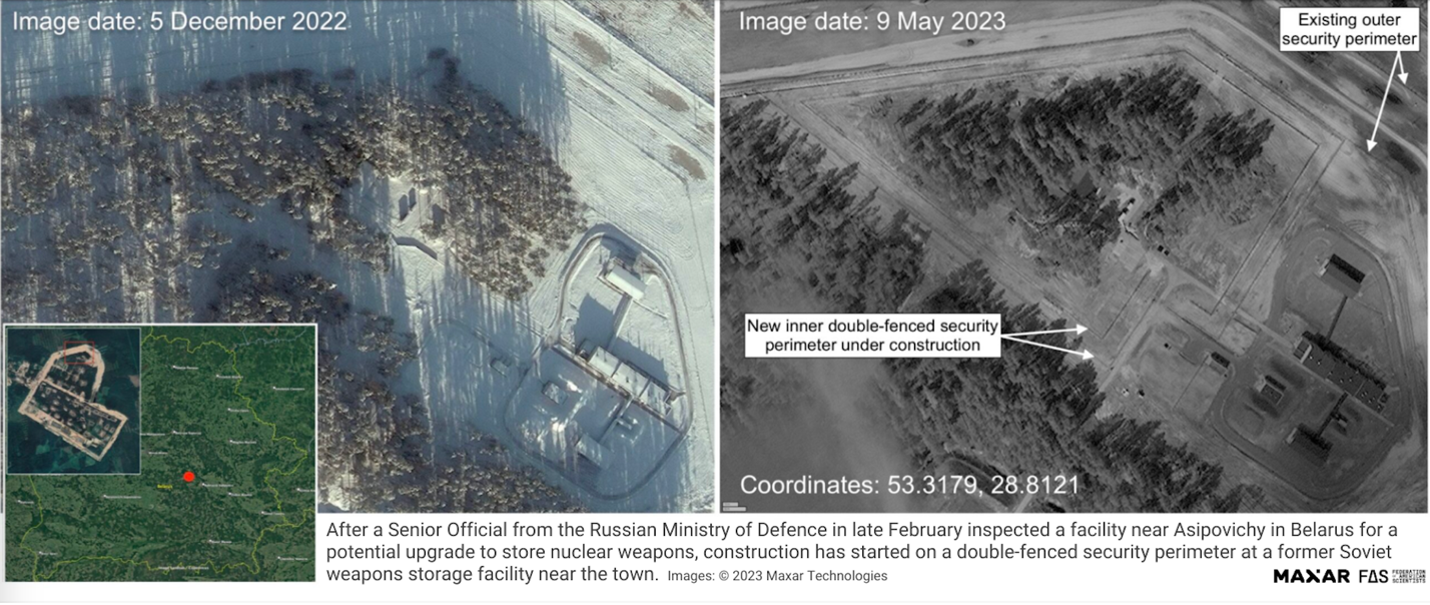
Shortly after a Russian defense official inspected possible nuclear weapons storage site near Asipovichy, construction of additional security perimeters began at depot.
New satellite images show that the construction of a double-fenced security perimeter is underway at a weapons depot near the town of Asipovichy in central Belarus.
The US Central Intelligence Agency reported in late-February 2023 that a senior officer from the Russian Ministry of Defense had inspected a facility in the vicinity of Asipovichy (occasionally also spelled Osipovichi) for a potential upgrade to nuclear weapons storage.
Asipovichy is the deployment area for the dual-capable Iskander (SS-26) launchers that Russia supplied to Belarus in 2022. Interestingly, the weapons depot featured in this article is roughly only 25 kilometers southeast of a vacant military base that, according to the New York Times, could be used to house relocated Wagner Group fighters in Belarus. This does not, however, imply any connection between the Wagner Group and Russian nuclear deployments in Belarus, which would be overseen by the Russian Ministry of Defence’s 12th Main Directorate (also known as the 12th GUMO).
President Vladimir Putin announced in March that Russia plans to complete a nuclear weapons storage site in Belarus by July 1st, 2023, but he later modified the timeline to July 7th-8th, apparently due to delays with preparing the storage facilities.
It is important to emphasize upfront that at this stage, we are not able to make a positive identification that this site is intended for or will definitively be used to store Russian nuclear weapons in Belarus. As we discuss in detail below, while the construction timeline and some signatures correlate with a potential nuclear storage site, other signatures do not, and these raise uncertainty about the purpose of the upgrade at the Asipovichy depot. In fact, overall, we are underwhelmed by the lack of visual evidence of the construction and infrastructure that would be expected to support the deployment of Russian nuclear weapons in Belarus. We have also surveyed satellite imagery of numerous other military facilities at locations mentioned in various reports, but we have yet to find visual evidence that conclusively indicates the presence of an active nuclear weapons facility on the territory of Belarus.
Below we survey facilities at various locations in Belarus that have been mentioned in the public debate as potential transit or deployment areas for nuclear-capable forces or even nuclear weapons.
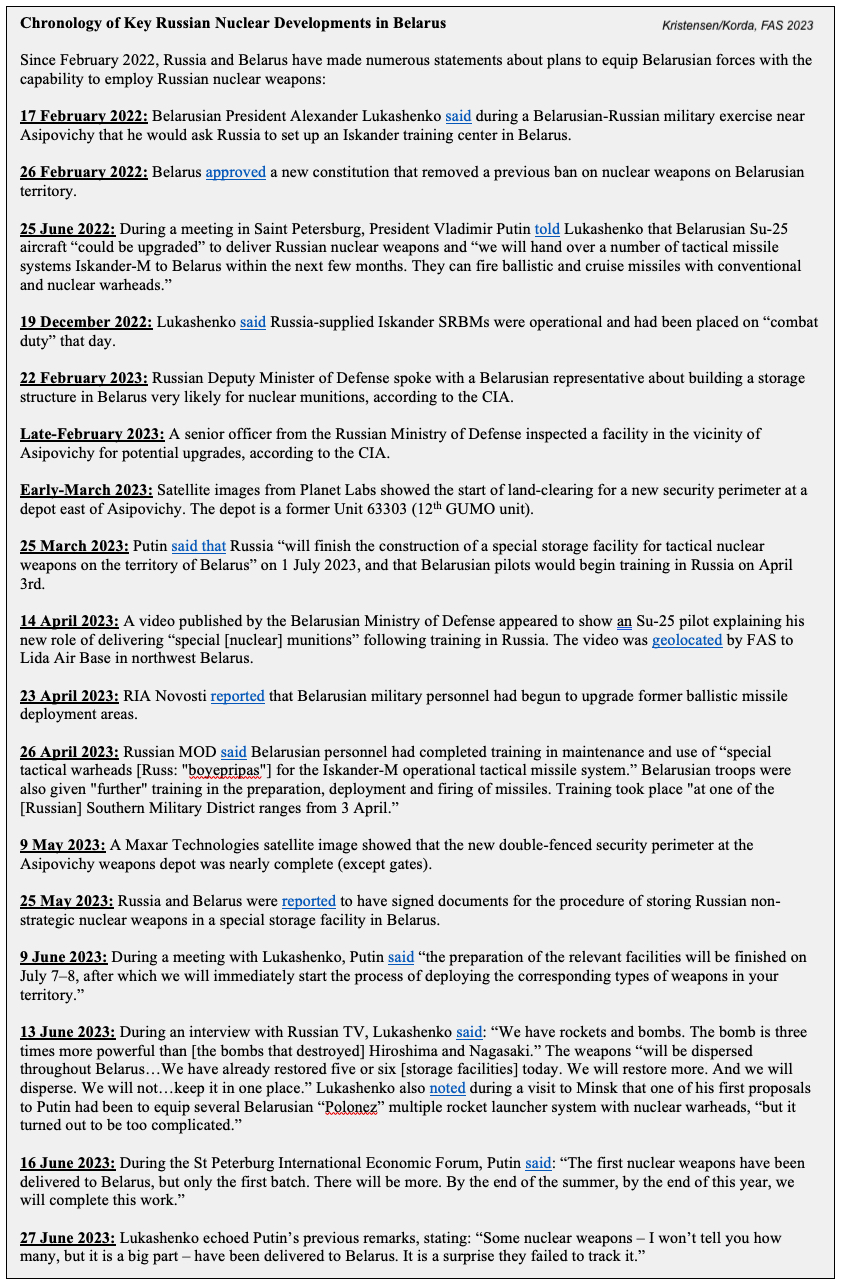
Iskander Missile Launchers
Asipovichy is an important region because it is the location of new nuclear-capable Islander short-range missile launchers that Russia transferred to Belarus in 2022. One Belarusian news report stated the transfer happened in December, but satellite images show what appear to be Iskander launchers at the training site to the west of Asipovichy in August and October 2022 (see images below).
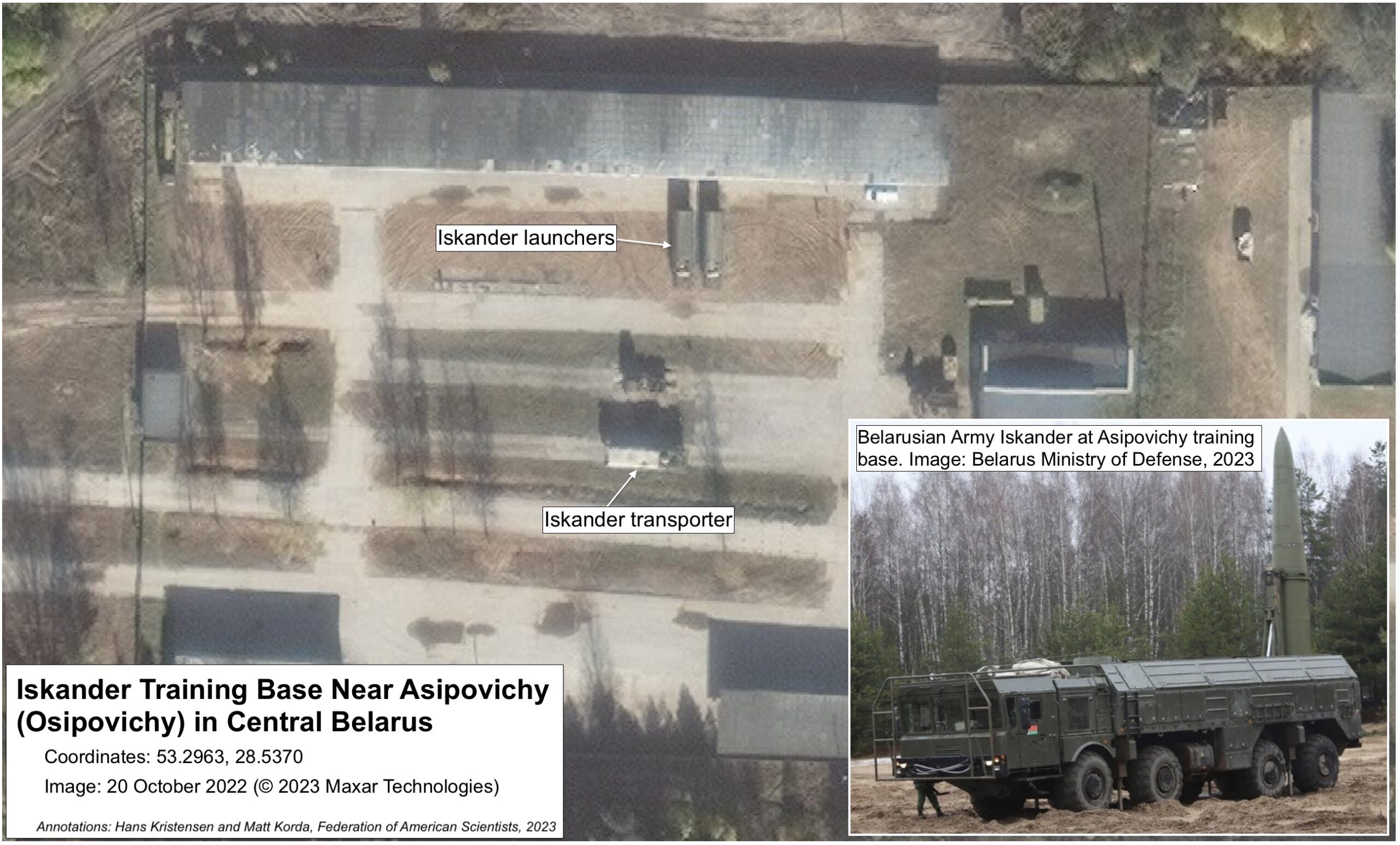
Iskander launchers have been observed at a training range west of Asipovichy several times.
The Russian Ministry of Defense announced in late-April 2023 that Belarusian personnel had completed training in maintenance and use of “special tactical warheads [Russ: “boyepripas”] for the Iskander-M operational tactical missile system” at one of Russia’s Southern Military District ranges in early April.
The Belarusian brigade base for the Iskander launchers is thought to be located in the southern outskirts of Asipovichy, roughly seven miles west of the depot undergoing upgrades. Some five miles to the west of that garrison, there is a training range where Iskander launches have been seen on several occasions (see image below).
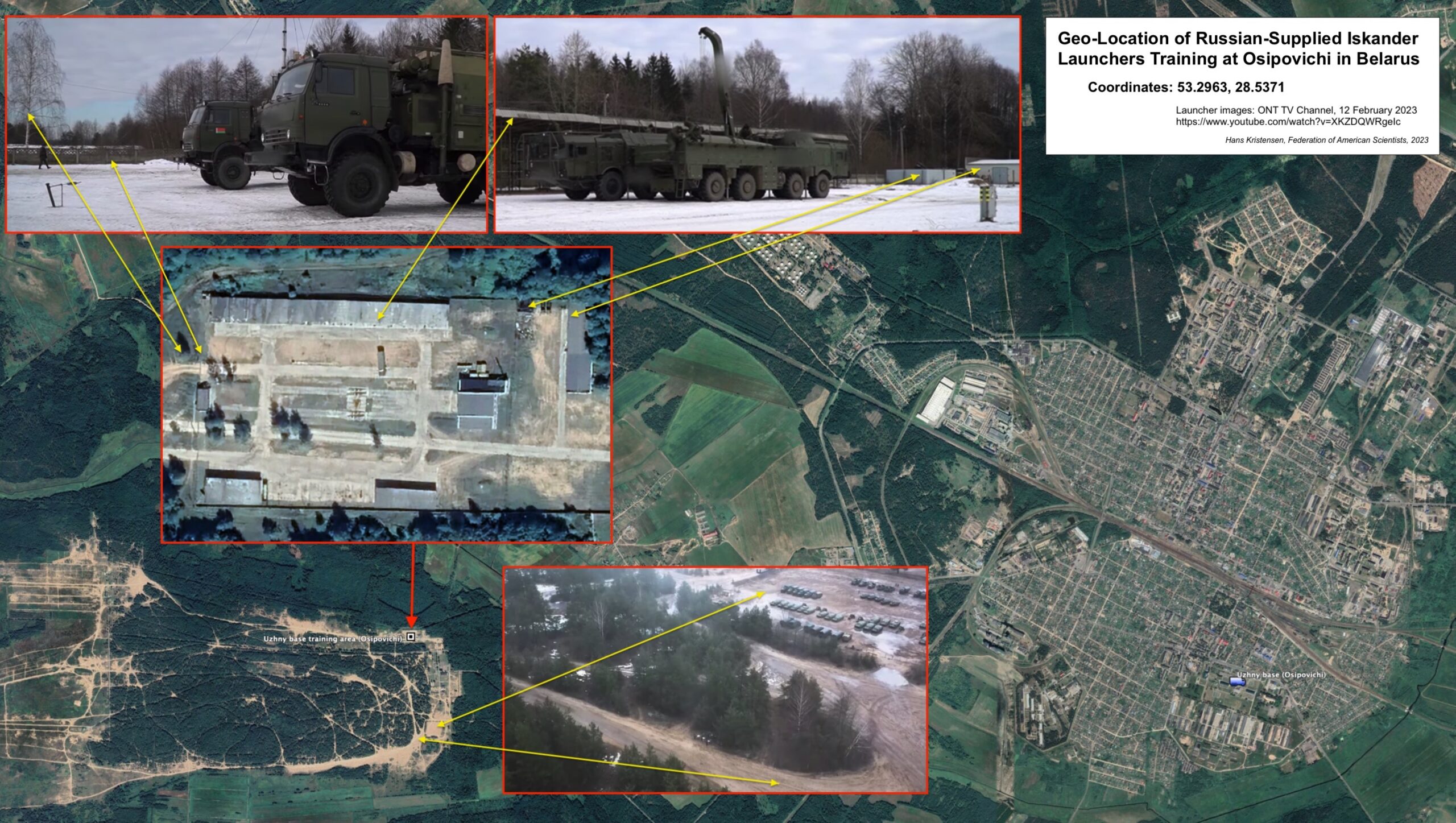
Belarusian Iskander military photos were geolocation to the training range west of Asipovichy.
Most Russian Iskander bases have extensive support facilities as well as a distinctive missile storage site (see image below). No similar facility has been found near Asipovichy. The Belarusian military probably uses different storage standards and could potentially use the dirt-covered bunkers in the south-west corner of the facility.
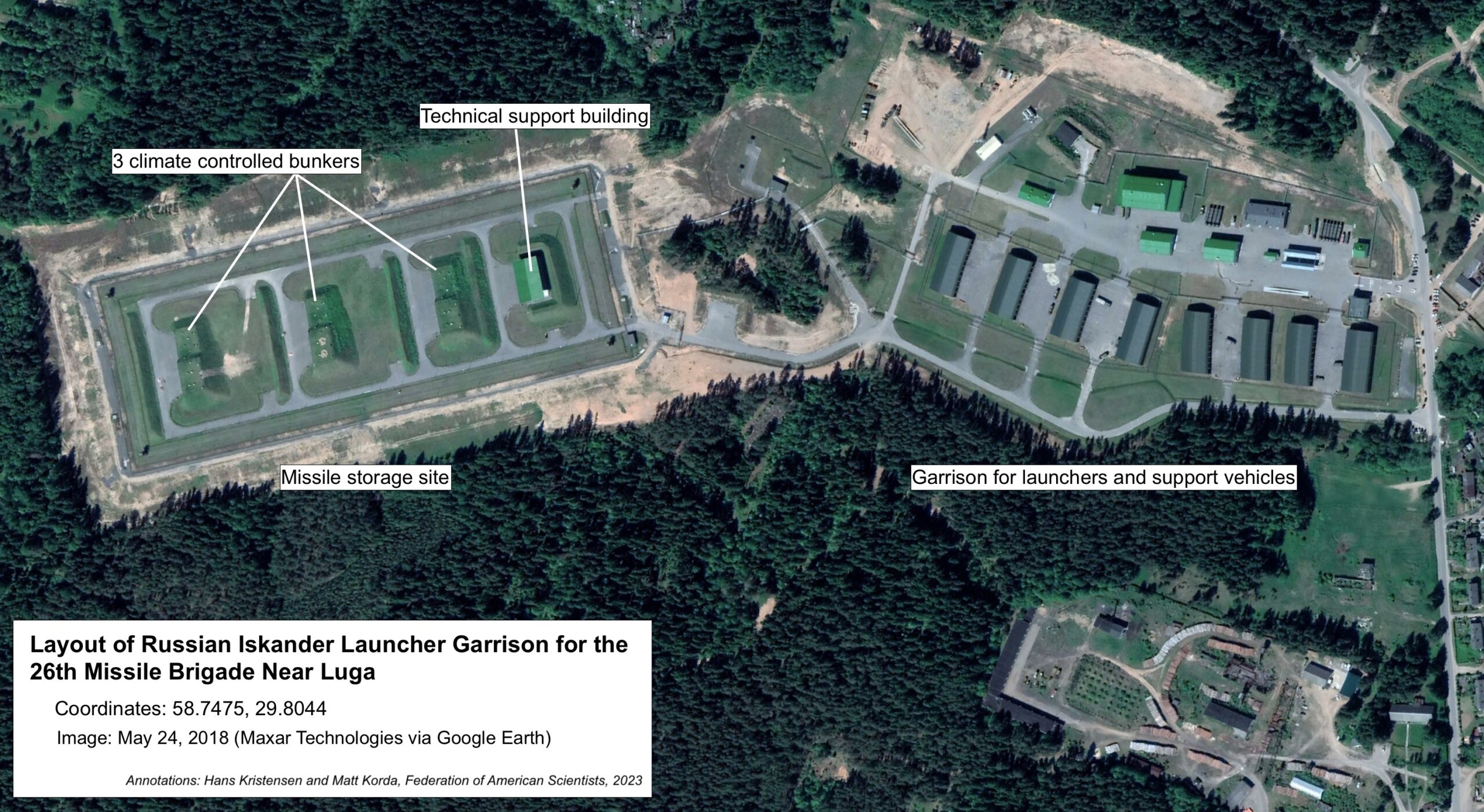
The Belarusian Iskander base does not include the distinctive missile storage site found at most Russian Iskander bases.
A few Russian Iskander bases also do not have the more elaborate missile storage site. That includes the Iskander base in Kaliningrad.
Fighter-Bomber Aircraft
In their public remarks during a meeting in St. Petersburg on 25 June 2022, Presidents Putin and Lukashenko explicitly mentioned nuclear upgrade of Belarusian Su-25 aircraft. A year later, on 14 April 2023, the Belarusian Ministry of Defense published a video of what appeared to be an Su-25 pilot at Lida Air Base explaining the new nuclear role.
An examination of the Lida base area shows no physical indications of upgrades of the kind that are thought would be required to support nuclear weapons deployment. The very latest imagery shows early construction of what appears to be an additional security perimeter around the munitions storage area at the base (see image below). It is too soon to tell, but as in the case of the Asipovichy upgrade, a second fence security perimeter does not necessarily suggest a nuclear weapons upgrade; it could simply be improvement of an existing security infrastructure.
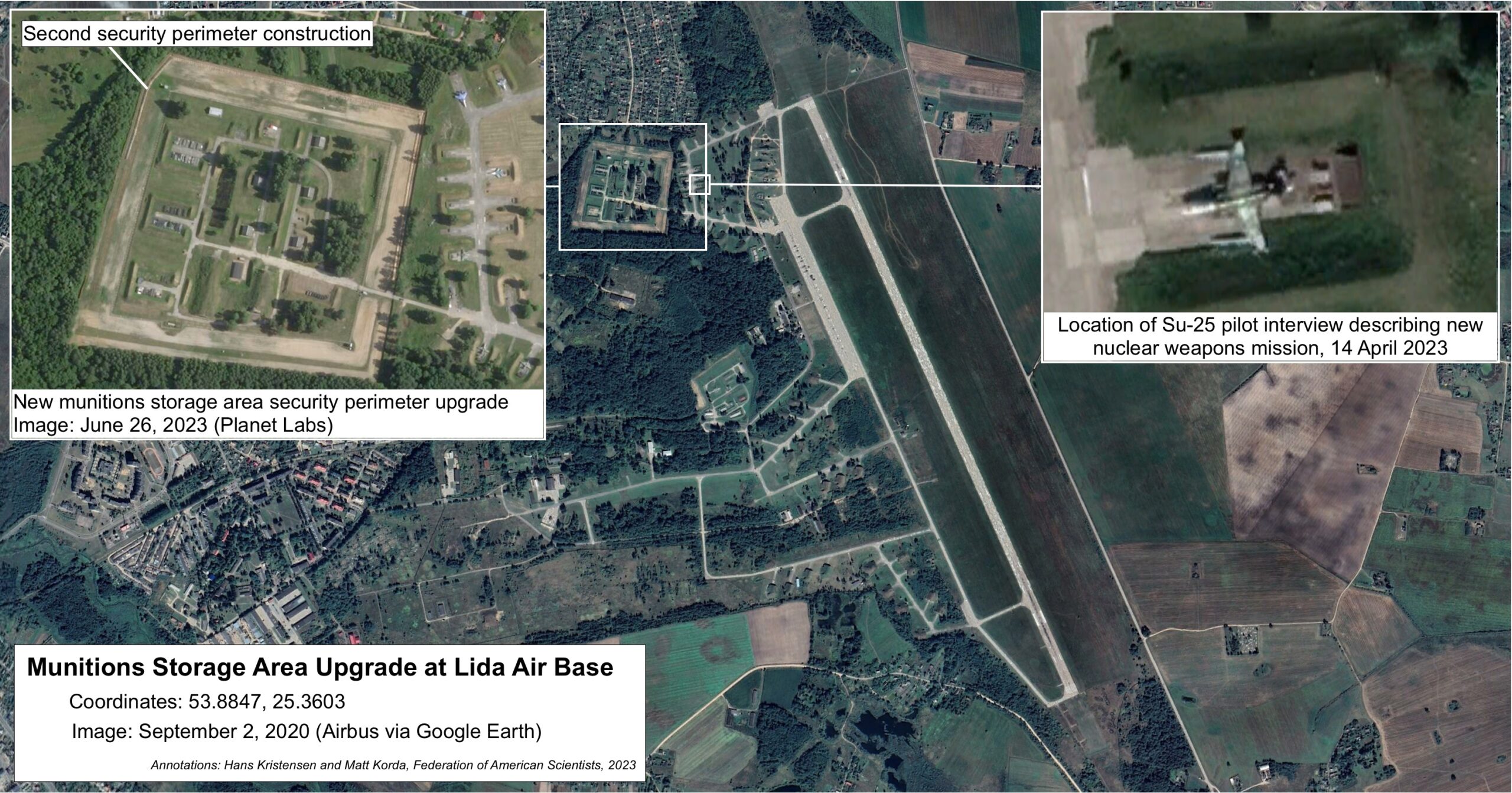
Construction of a second security perimeter at Lida Air Base has begun but there is yet no clear indication this is related to nuclear weapons.
There have also been some speculations that the Baranavichy Air Base further to the south, which is equipped with more modern Su-30SM jets, might be a potential candidate for the nuclear mission. We are not aware of any official statements to that effect and have not seen any observable indications of physical upgrades needed to support nuclear operations there.
As with the Iskander base area upgrades near Asipovichy, we can’t positively exclude the existence of an undetected facility near the western air bases. But so far, we don’t see conclusive physical indications of nuclear weapons related upgrades on or near Lida or Baranavichy. It is also relevant to mention that both bases are very close to NATO territory; Lida is only about 20 miles (35 kilometers) from Lithuania.
Warhead Transportation
On June 16th, Putin announced: “The first nuclear weapons have been delivered to Belarus, but only the first batch. There will be more. By the end of the summer, by the end of this year, we will complete this work.”
Careful monitoring of the 12th GUMO’s transit hub at Sergiev Posad has not yet indicated the shipment of specialized nuclear-related materials, such as fencing, certified loading equipment, vault doors, or environmental control systems. However, on June 27th, a group that monitors the Belarusian railway industry reported that nuclear weapons and related equipment would be delivered to Belarus in two stages, one in June and one in November––echoing Putin’s delivery timeline. The group reported that the shipments would involve three departures planned from Potanino, Lozhok, and Cheboksary stations in Russia, arriving at Prudok station in Belarus––more than 200 kilometers north of the Asipovichy depot. These locations in Russia are hundreds of kilometers away from known nuclear storage sites, and so could either be locations for subcomponents or security equipment rather than the warheads themselves, or they could potentially be an attempt to obfuscate where the warheads would actually be coming from.
Preparation of rail transfer points and storage would require construction of a number of unique security features and support facilities. An examination of satellite images of the Prudok station area in Belarus, however, revealed no observable indication of construction needed to safeguard nuclear weapons (see image below).
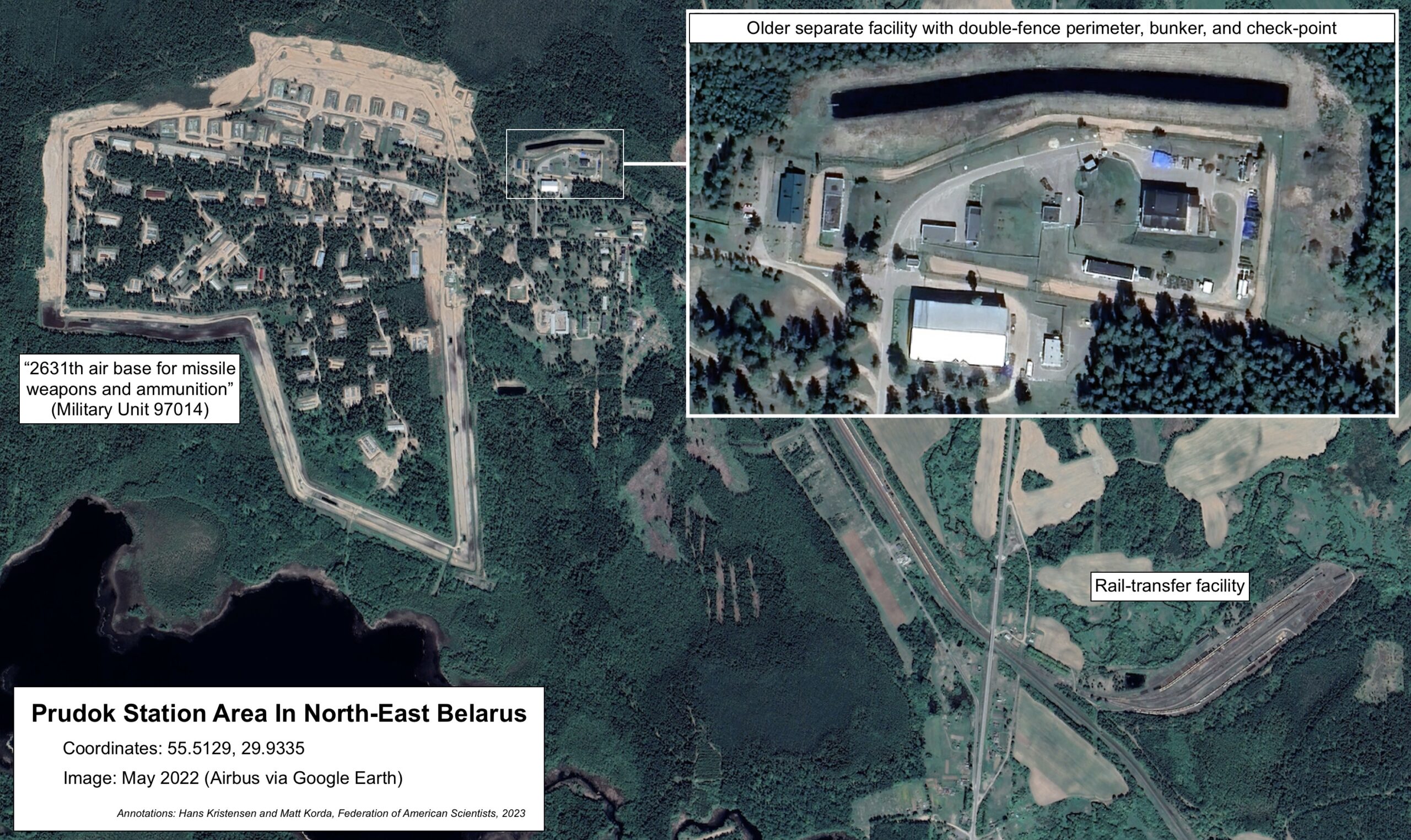
Satellite imagery of the Prudok rail station and depot area reported as the first transfer point of Russian nuclear weapons into Belarus show no observable indication of preparations to nuclear weapons storage.
Many Uncertainties
It is important to be clear that these satellite images do not prove decisively that the construction at Asipovichy or other known facilities is related to nuclear weapons storage. It could potentially be related to non-nuclear weapon systems, such as air-defense missiles. There are several uncertainties that should be mentioned and carefully considered:
First, the security perimeter has two inner fences, less than the three or four normally seen at Russia nuclear weapons storage sites. This is a significant difference, because the standard of at least three layers of fencing is directly correlated with the ability of the fence disturbance system to detect security threats to the complex. Fewer layers of fencing (and thus less clear space) could cause the microwave detection system to be accidentally triggered by movement inside the complex itself. To avoid that, vegetation has been removed along the new 12-meter wide inner security perimeter. Construction is ongoing and there is so far no visual indication of electronic sensors inside the new perimeter.
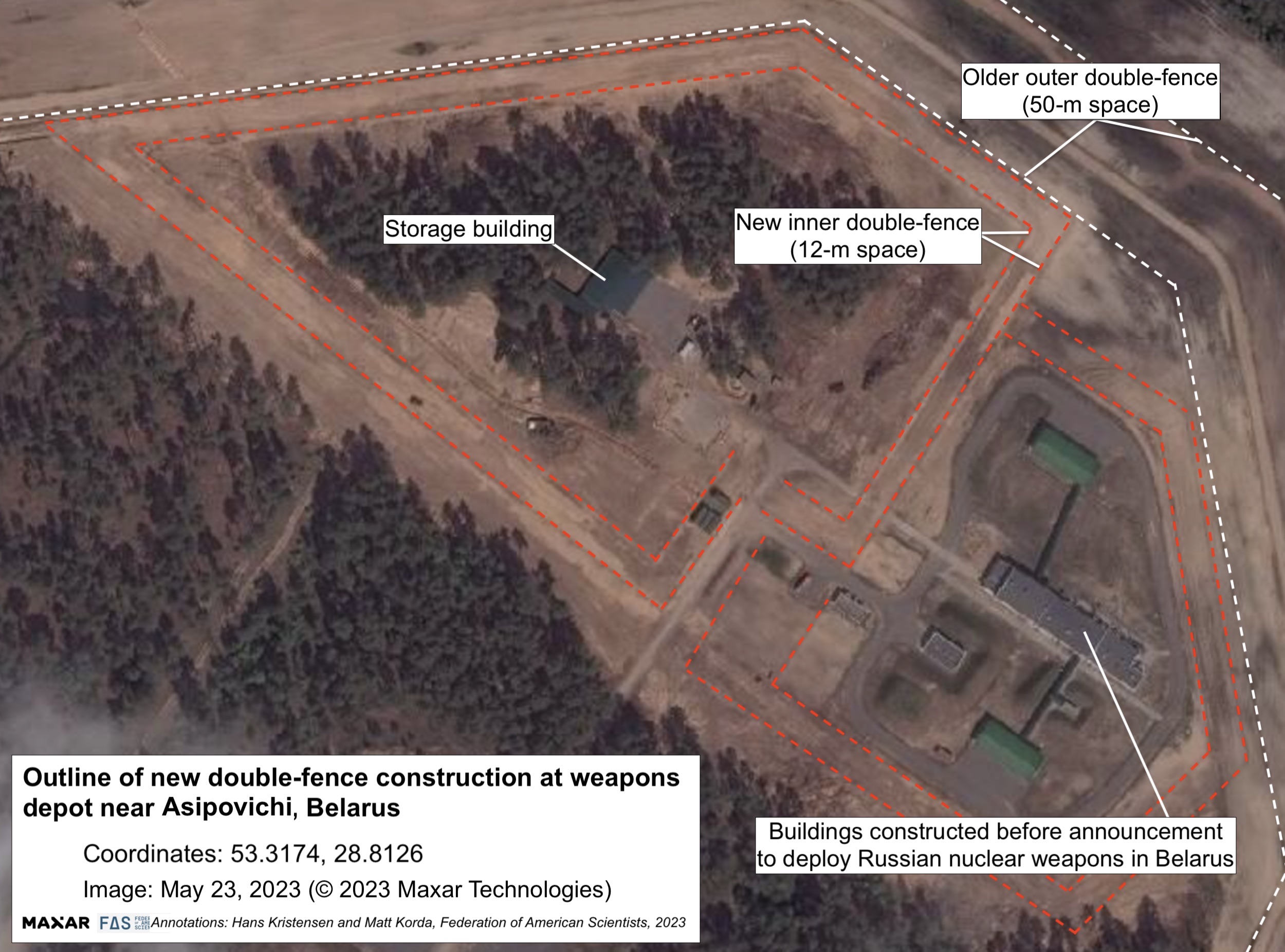
Construction of an additional double-fence security perimeter began at a weapons depot east of Asipovichy in central Belarus shortly after a senior Russian defense official inspected a facility in the area for potential storage of nuclear weapons
In comparison, Russian base- and national-level nuclear weapons storage facilities have extensive security features. The base-level storage facility near Tver approximately 325 kilometers (200 miles) from the Belarusian border has considerably stronger security features around the weapons bunkers (see image below).
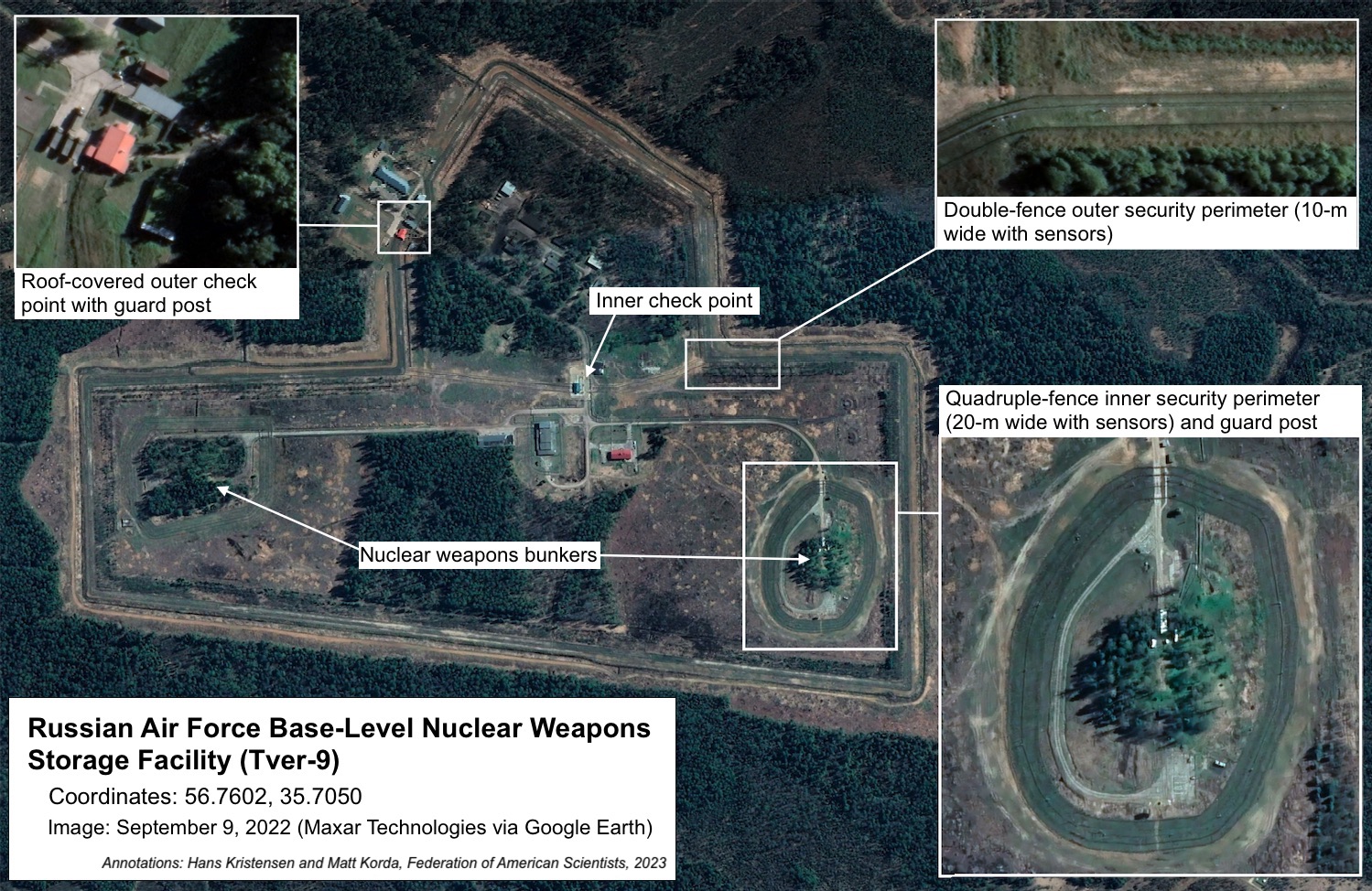
The outline of this Russian base-level nuclear weapons storage site near Tver is very different from the Asipovichy site.
Second, there is no bunker visible inside the enclosure, another normal feature of Russian nuclear weapon storage sites. Apart from physical protection, nuclear weapons require climate-controlled storage facilities.
Third, there is no visible segregated housing for the large number of Russian 12th GUMO personnel that would be needed to protect and manage nuclear warheads.
Fourth, the depot is next to a storage site for conventional high explosives. As other researchers have pointed out, it would be highly unusual for conventional and nuclear warheads to be stored within the same perimeter in order to maintain the security of the warheads and to segregate the chain of custody between Russian 12th GUMO personnel and Belarusian army personnel.
These differences could potentially be explained if the Belarusian site is a temporary transit site and not intended for permanent storage, but rather to introduce nuclear weapons in a crisis.
It is also curious that part of the new double-fence construction extends around a group of buildings that were constructed in 2017-2018, long before any statements were made about deploying Russian nuclear weapons in Belarus.
Even if Russia intends to follow through on its planned construction of a storage site in Belarus, it is not guaranteed that any nuclear weapons would actually cross the border in peacetime. Rather, it is possible that Russia’s actions instead constitute the building blocks for a potential future decision on deployment. Moreover, some analysts have suggested that these actions could be deliberately designed to remind the West of Russia’s nuclear-armed status, rather than actually shift Russian force posture.
In total, the facility upgrade at Asipovichy is important to monitor given the CIA report about Russia nuclear-related storage inspections in the area. So far, however, our observations and analyses show no clear observable indicators of construction of the facilities we expect would be needed to support transport and deployment of Russian nuclear weapons into Belarus. As always, we don’t know what we don’t know and it is of course possible that there are other facilities that we are not aware of that would indicate nuclear weapons activities.
Positive identification of this and other potential facilities will have to await additional information. And we look forward to the contribution of other researchers.
This research was carried out with generous contributions from the John D. and Catherine T. MacArthur Foundation, the New-Land Foundation, Ploughshares Fund, the Prospect Hill Foundation, Longview Philanthropy, the Stewart R. Mott Foundation, the Future of Life Institute, Open Philanthropy, and individual donors.